TE RAU ORA Life




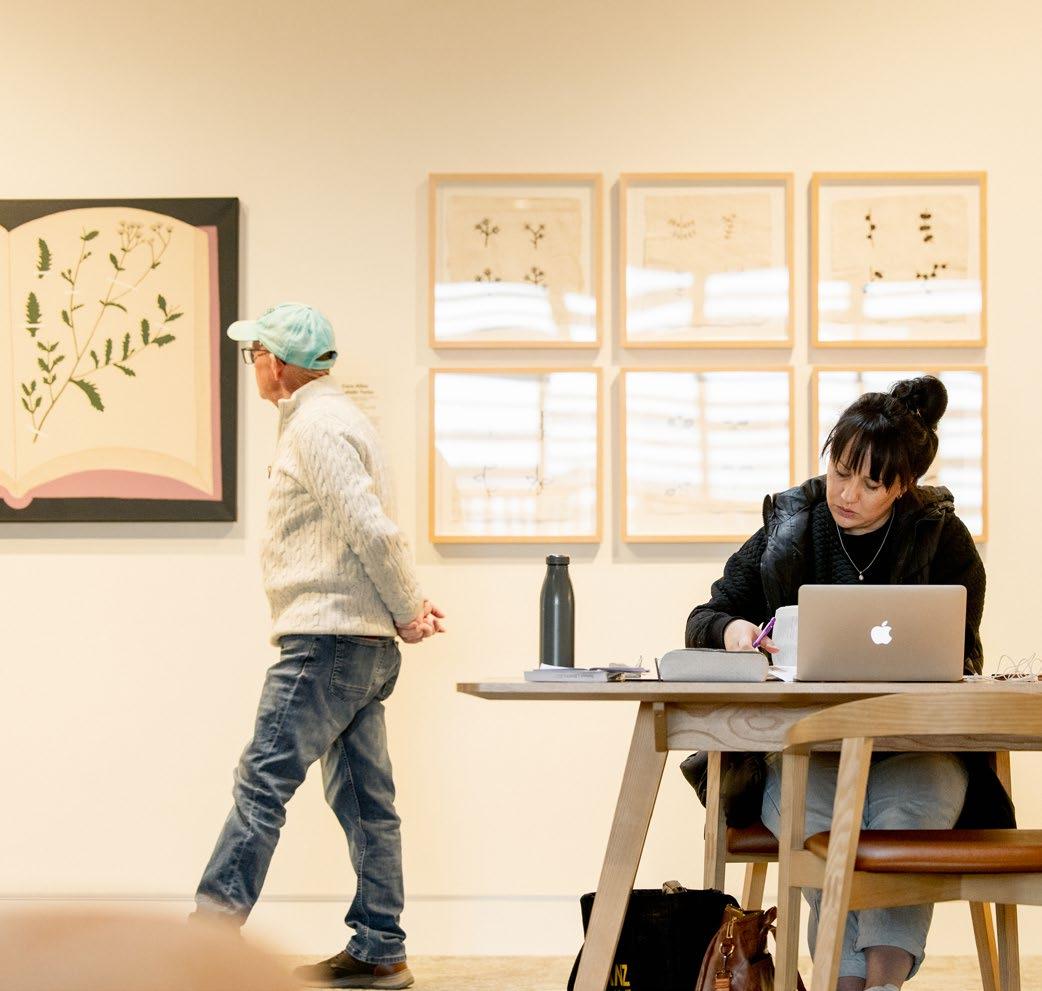
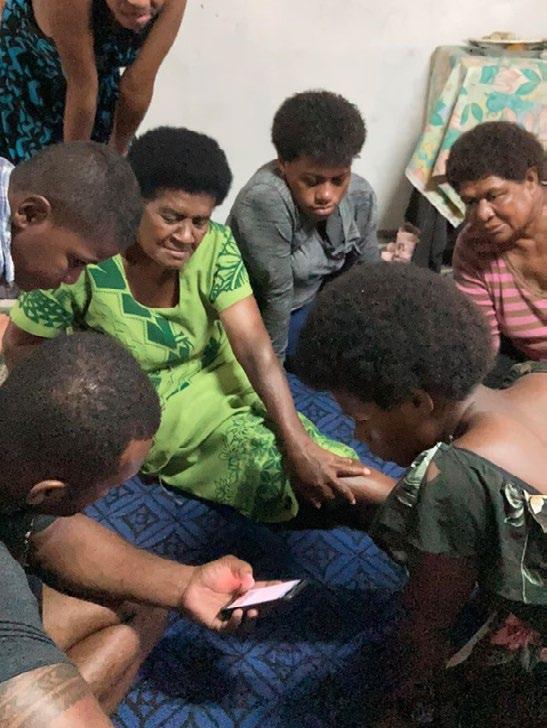
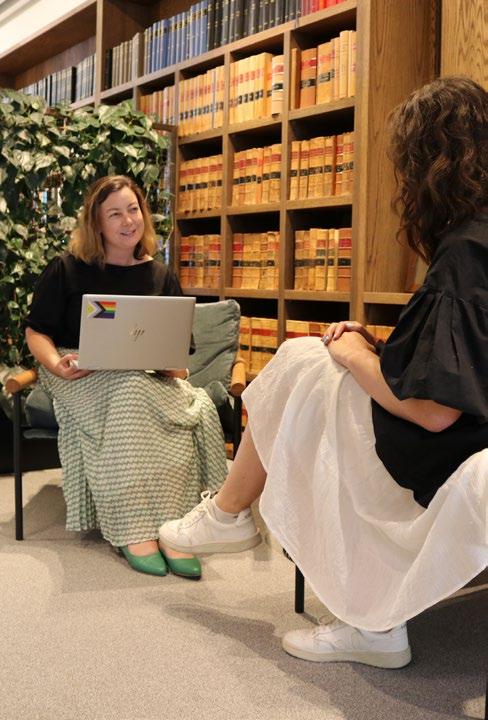
07 FEATURES NGA TOHU
The partnership behind Te Ara Ātea
IHC Library’s Stand Tall online game
Far North District Libraries’ Raumati Toa Summer Legends
15 NEWSBOARD PITOPITO KŌRERO
It takes a village: books, schools and reading culture
A celebration of recent Māori and Pasifika books
Another look at DigitalPasifik
The New Zealand Legal Information Institute
23 REGULAR COLUMNS
Library Mahi: Erin Cairney
Library of the Issue: St Patrick's College Library
Tertiary Profile: From Ghana to Open Polytechnic History Corner: Freedom to read
Freedom for Information: Is it appropriate for the collection?
Climate Action: Climate Action statement
COVER IMAGE
Mayor Moko stopping into Kaeo Library to share some cards with local tamariki.
Image credit Ange Simonsen
EDITOR & ADVERTISING
Angela Cairncross
LIANZA Communications Advisor
angela@lianza.org.nz
LIANZA Media Kit available on request
DESIGN
Jess Buchanan-Smith
LIANZA Office & Design Manager
WEB
https://librariesaotearoa.org.nz/ library-life
EDITORIAL STATEMENT
Library Life is the digital magazine of New Zealand’s Library and Information Association Te Rau Herenga o Aotearoa. Providing a voice for the views and news on issues relating to the GLAMIR sector. You may use material found in this publication in accordance with the Creative Commons Attribution 4.0 CC BY licence for any purpose if the original creator is acknowledged.

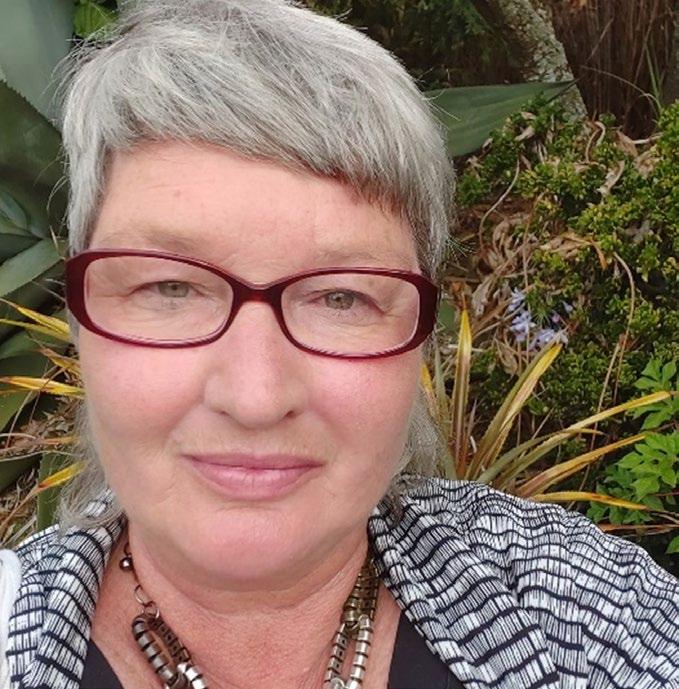
FROM THE EDITOR NĀ TE KAITĀTARI
ANGELA CAIRNCROSS
The April issue of Te Rau Ora Library Life is here.
It features the partnership with iwi behind Te Ara Ātea in Rolleston. Developing a reading culture in schools and the latest Kete Māori and Pasifika books are discussed. We learn about the Far North Libraries' successful Raumati Toa summer programme and the IHC Libraries’ Stand Tall online game.
Law library specialist and NZLLA president Erin Cairney talks about her library mahi, and we feature the new library at St Patrick’s College in Wellington. We also have some important sites you will want to know about: DigitalPasifik and the New Zealand Legal Information Institute.
Reading Te Rau Ora Library Life is a great way to learn about what's happening around the sector and explore the work of colleagues and peers.
If you're interested in sharing your own experiences, collaborations or projects, submissions for the June issue open on May 15.
Ngā mihi nui
Angie Cairncross LIANZA Communications Advisor
FROM THE PRESIDENT
N Ā TE TUMUAKI
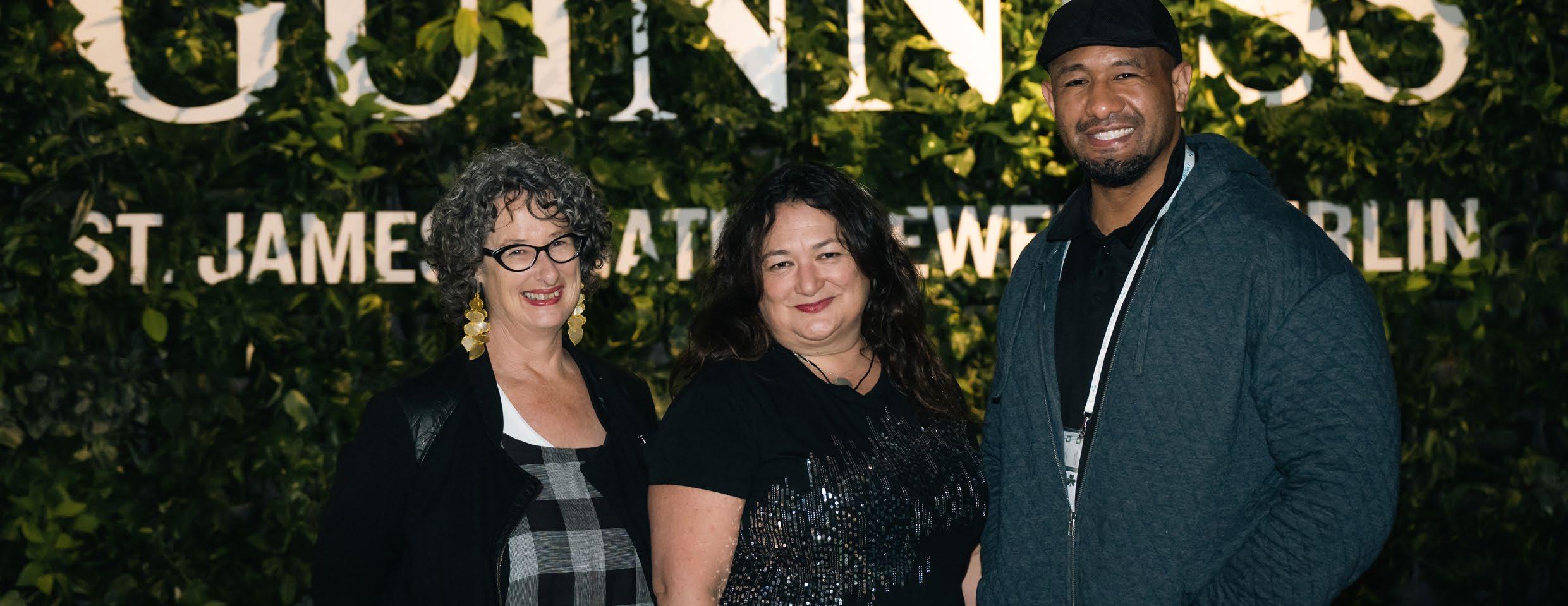
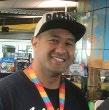
RICHY MISILEI LIANZA PRESIDENT
Mālō le Soifua Maua ma le Lagi e Mamā
This is the last president’s column that I will write before Ivy Guo takes over as LIANZA president. I came into this role with ambitious plans to lift our sector into the public eye and build stronger relationships with other associations. I had some pivoting to do when there was a recruitment process to lead, the LIANZA Conference to oversee, and ‘behind the scenes’ work to deal with. But all of it was focused on strengthening this
incredible association to thrive in this ever-changing world.
In the spirit of transparency, I want to tell you that the work has been hard. But please understand I don’t say this to put a negative light on my experience or to garner sympathy. No, I say this because I’m confident many of you may be in a similar boat. Like me, you are appreciative and enthusiastic about the mahi, but it can be mixed with feelings of weariness and anxiety. I recall a quote from a preacher saying that if one were to preach about difficult times, you would always have a listening audience. And in this case, I know I’ll have people’s attention because, let’s face it, times are challenging! With preaching, though, the end goal isn’t just to point out a grim situation but to offer hope by, for example, leading people to God, the only one who can highlight why life can be so gruelling and offering himself as the remedy.
And just like preaching, my goal here isn’t just to highlight the challenges we’re facing but also to offer hope. I want to remind you how resilient our sector is. The library and information sector always seems to be challenged in some form or another. Whether it is an elected member or manager who has a limited understanding of our mahi and challenges our value, a new technology that will apparently threaten our existence or the seeming competition between us and other parts of the organisation we work in chasing after a limited pot of funding. Kim Taunga and I had a great discussion with the most recent kākaho from the Whiria te Tāngata programme around this. Yes, we pivot and get on with it! We push through the difficulty because we know how much our sector is needed in our schools, tertiary institutions, corporate spaces, government departments, neighbourhoods,
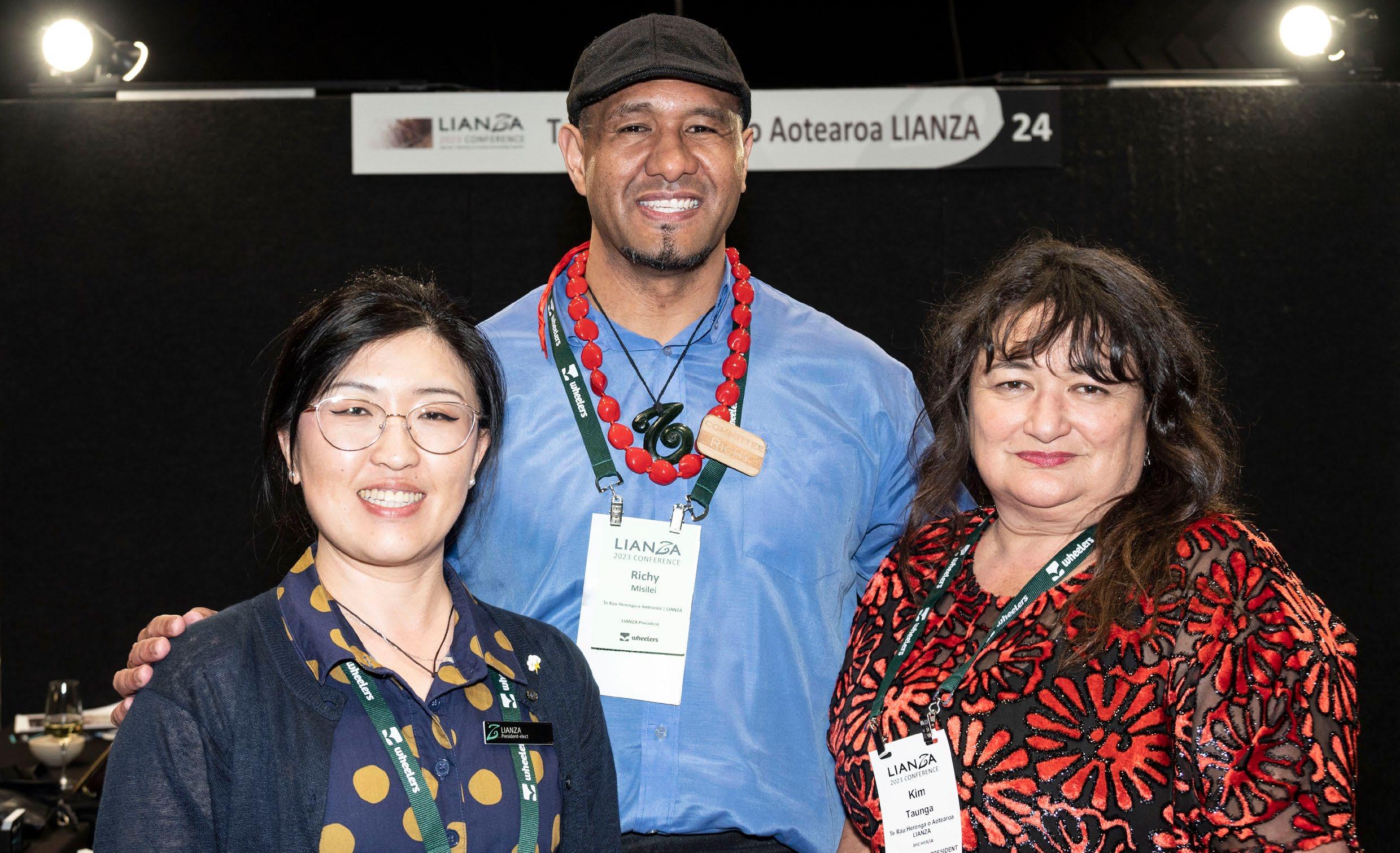
and communities. So where is the hope here? It is in our sector and our innate desire to serve. And who is the sector? It’s you, me, it’s all of us!
Speaking of serving, this is the perfect segway into talking about the up-and-coming LIANZA Council elections. Do you want to play an important role in achieving LIANZA’s vision of a thriving library and information sector? LIANZA seeks nominations for our next president-elect and elected national member by Thursday, April 18. Honestly, it is an amazing opportunity to enable the hope that is needed by our sector, and that our sector uniquely provides to the world.
I want to acknowledge a few people who have supported me during my presidency:
• The passionate LIANZA Council that I work with, particularly Kimberley Symon (treasurer), who helped to take on ED responsibilities when Ana left, others such as Denise Wilson and Tracy Maniapoto, who were ‘voluntold’ for projects in the absence of an ED.
• The LIANZA office, most notably Angie and Jess, for their efforts in navigating the hole created without an ED.
• Kim Taunga, my direct manager and immediate past president, has been incredibly supportive of me in my role and paved the way for another Pasifika person to take on the presidency.
• The LIANZA Conference Committee 2023 and Danielle for welcoming me as a late edition conference convenor.
• Finally, my beautiful wife, Jolene Misilei, and my daughter, Grace, for always cheering me on and lifting me up when things became burdensome, alongside my parents and siblings.
Fa’afetai i le Atua mo lona alofa and agalelei mo a’u ma lenei tupulaga. Thanks for the opportunity to serve as LIANZA President. I truly appreciate it! Nga mihi nui ma ia manuia –God bless,
Richy Misilei
Te Rau Herenga o Aotearoa LIANZA President
THE PARTNERSHIP STORY BEHIND ROLLESTON’S TE ARA ĀTEA
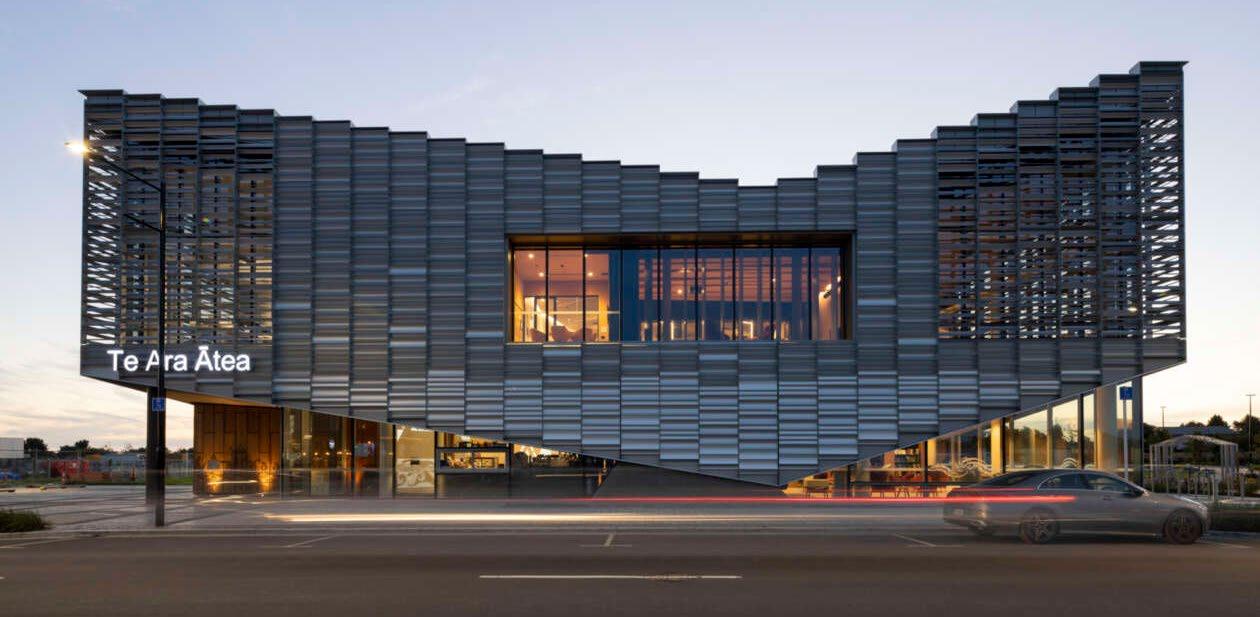
This article was created by Selwyn District Council in partnership with Creative New Zealand Toi Aotearoa for their localism and culture site. It looks at the partnership story behind Rolleston’s Te Ara Ātea and has been reprinted here with permission.
In December 2021, when Selwyn District’s mayor, Sam Broughton, cut the ribbon on Te Ara Ātea, a multipurpose library, museum, art gallery and community facility located in the Rolleston town centre, he felt a real sense of pride. Opening a building of this quality was a clear sign that the town had matured, both physically and culturally, and two years on, his pride has only increased.
“I love it,” he says. “I was there last night, and I went for a walk around it after our citizenship ceremony. It’s a beautiful building. It’s the inspiration for things.”
Broughton says Te Ara Ātea’s success is largely due to the collaboration between the Selwyn District Council and mana whenua that has helped imbue it with a real richness and distinct sense of place.
He says there had been a lot of talk about what the council could do with the local hapū of Ngāi Te Ruahikihiki, but little had come to fruition, and he freely admits that engagement was lacking in previous councils.
“I’ve really tried to lean into [the partnership potential]. So, a key part was mana whenua being involved in this project from the beginning … This is about healing and a new age of cooperation with Ngāi Tahu.”
Nicki Moen, who had worked with Workshop E on the Foxton Te Awahou Nieuwe Stroom—a Māori, Dutch, and Pākehā history museum—and acted as Head of Arts, Culture, and Lifelong Learning at Selwyn District Council, was asked to develop a design brief for a new library and community facility in Rolleston in 2014.
At the time, there was a simple 300sqm library, but as one of the fastest growing regions in the country, it was felt “an anchor building” was needed as part of the city centre development plan.
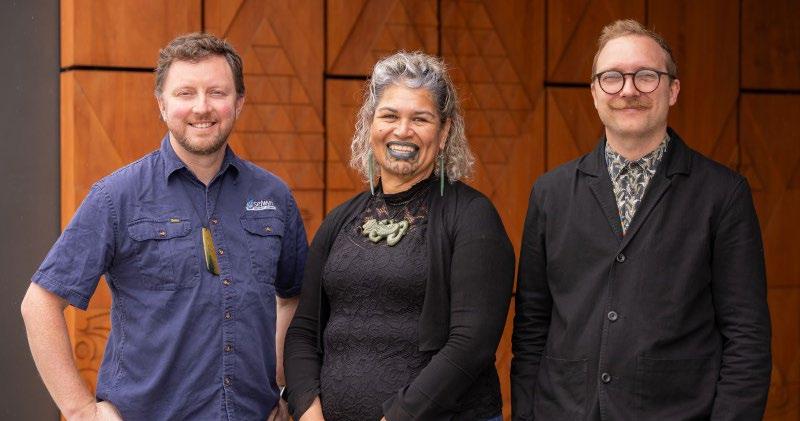
A couple of years later, the local rūnanga prepared a cultural narrative for the council that talked about the importance of telling the story of the land and bringing the culture back out. These projects overlapped, and whereas in previous years the rūnanga may have been asked for a name after a building was completed, this was the first project to be co-designed. The name Te Ara Ātea, which translates as an unobstructed trail to the world and beyond, was gifted to the community early on.
Broughton says there was some controversy over the name when it was announced, with complaints to local media about the fact that it didn’t have an English translation or a literal description of what the building was for, but that has now subsided.
“As soon as you name it, you give it a theme,” says Puamiria Parata-Goodall, who worked on the cultural narrative and is now employed by the council. And that theme informs the design, the layout and the materials.
“For an architect, it’s gold,” she says, and because the story is integrated from the beginning, it’s part of the fabric of the building. “You can’t remove any element. It is grounded and balanced.”
She says her tupuna/ancestors came to the region because of Te Waihora (Lake Ellesmere)
and early sketches of pa show storehouses on tall stilts. It was a landscape of abundance, and the storehouses were landmarks that could be seen from a distance.
“It came out of that kōrero and being able to see beyond the horizon. It was about that migration into and across the plains, along the trails between mahinga kai,” she says.
Te Ara Ātea is another mahinga kai, she says, “a place to grow, harvest and nurture resources, whether that’s our matauranga/knowledge or the people and the place."
For Parata-Goodall, the project was about “rebalancing the narrative” and Broughton points to features like the bilingual signage, something that hadn’t been common in council buildings previously; the exterior wooden panels based on the work of Cath Brown that are not just building materials but pieces of art; the bronze tuna/eel sculpture Te Hekenga by artist Piri Cowie, you see when you enter; and the Te Waka Huia room that was inspired by the wooden boxes rangatira/ leaders kept their treasures in.
Much like the international movement to return treasures to their original homes, Te Ara Ātea now also has a pounamu pendant that was found on the

Kaitōrete Spit and was made around 200 years ago. It had been in the Canterbury Museum collection since 1938, but when there was a place for it, “we called it home,” says Parata-Goodall.
Moen says the co-design process has given “a deep beauty and peace to this building, unlike any other project I’ve worked on in the country.”
“The building gets to you because it has been so carefully created. People can come in and find a place in it and be quite content. It’s perfect.”
Other elements in the building are unique to Selwyn, Broughton says, with a lot of the displays having a military focus and some of the landscaping inspired by rail corridors.
“That’s part of the recipe as well,” he says.
Mat Logan, Culture, Content and Learning Manager, says people moving to the district with young families were accustomed to the public amenities and art on offer in bigger cities, so it was about trying to meet those expectations. And many of them have also moved here recently, so it was also about placemaking and community building.
“How do we make them proud of the district and its histories and stories?”
Residents have good reason to be proud of the building itself: foot traffic is up by 40% over 2022 and last year it was awarded the Local Government
Outside the two-storey, 2,500sqm building, there is a youth recreation park, seating and a sensory garden designed by a local school. A sculpture created by Ngāi Tahu artist Dr Areta Wilkinson is set to be another spectacular addition to the area. Called ‘Toro Atua’ and part of the SCAPE public art project, it is inspired by the rock paintings of Te Waipounamu/South Island and is expected to be finished in April 2024.
“This is an enormous public artwork the scale of which Selwyn has never had before, and it will be a taonga for us to treasure,” says Logan.
“We wouldn’t have got the art project if we didn’t have Te Ara Ātea. It would have been some other art project of minor scale, without the storytelling or the meaning,” he says.
Council investment also tends to give the private market confidence and that’s certainly been the case in Rolleston. “There was nothing else like this here, so how can we expect private developments and other buildings to go up if we don’t aim for scale,” says Broughton. “We had to lead it.”
The lessons learned in this project are being put into practice elsewhere, like libraries in smaller towns like Darfield and Leeston. Other new buildings in the region like Ag Research’s Tuhiraki building at Lincoln University or Lincoln’s flagship
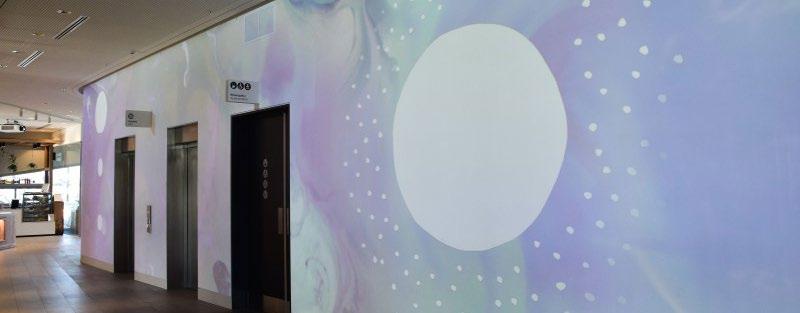
science building Waimarie have also embraced cultural narratives.
Te Ara Ātea really hit the mark from an iwi perspective, says Parata-Goodall, and it has also been a catalyst for a culture shift in council.
“When they experience it, they say ‘this is not all bad, this is kinda good’. Iwi engaging with the council was not a threat. So why don’t we build on this? We’re going to live the partnership, not just honour it. It’s not just what’s good for Māori, or good for this lot. It’s good for all of us.”
This has now led to the council employing experts from Ngāi Te Ruahikihiki, represented by its corporate entity Te Taumutu Rūnanga, to offer their cultural expertise across the organisation. Mana whenua has also been given representation at the council table, with full speaking rights but not voting rights.
Staff in the Arts, Culture and Lifelong Learning department have received training so they can share the story behind the name and the history of the region. Moen believes this deeper understanding and the connection to manaakitanga / hosting has helped to improve the customer experience, with satisfaction ratings increasing from 87% to 98%.
One major endorsement of the project is that Te Ara Ātea regularly hosts guests from the galleries, libraries, archives, and museums sector - and some of the public officials they’re trying to get funding from. They want to see if something similar could be done in their own region and while some ideas
are transferable, especially to smaller cities and towns, Broughton says it can’t just be copied.
“I’m really proud of what we’ve done, but you need to tell your own story locally. Be inspired by what we’ve done but follow what mana whenua would like to see and do and stay true to your history.”
Design by committee is often seen as a bad thing. But if you frame in a different way, it’s all about taking people with you and establishing the right relationships from the start so that you get a better result at the end. It’s not just about early engagement, however. It’s also about continuous engagement, says Parata-Goodall, and it’s important to recognise that providing a cultural narrative is a form of consultancy that needs to be paid for.
“We’re saying the cultural narrative is part of the basic infrastructure,” she says. “The cultural elements are just as important as the sustainability of the building.”
Broughton agrees and says working closely with mana whenua is about respecting the way things should have been done in the past.
“There’s a healing aspect to that but also about setting a future direction.”
And for Selwn, the future looks bright - and busy. “There might be 40,000 people [in Rolleston] soon,” says Moen. “It’s a sprawling mass of grey roofs, so to have Te Ara Ātea at the centre is important. This has given Rolleston a heart. And maybe it’s given the district a heart, too.”
IHC LIBRARY'S STAND TALL ONLINE GAME
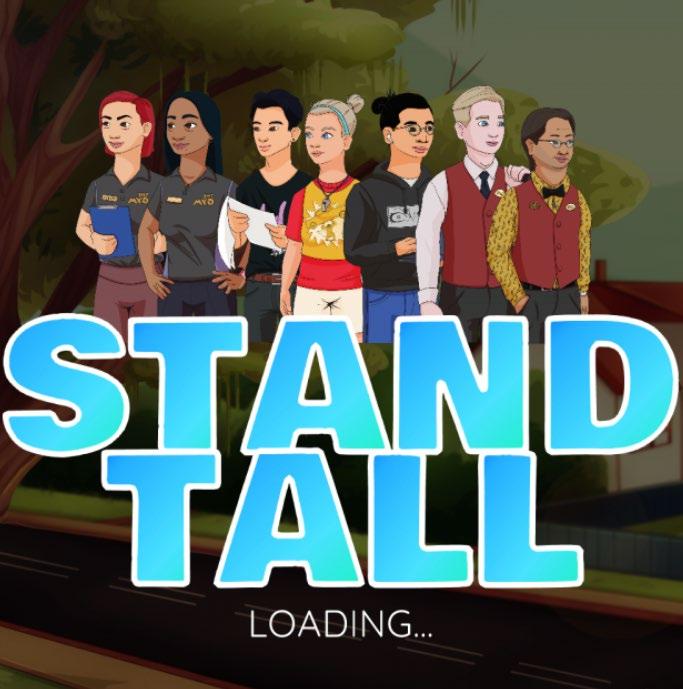
Stand Tall is a free online game for intellectually disabled or neurodiverse teens who are ready to leave home and become more independent. It was developed by the IHC Library and presented by Phil Clarke at the LIANZA2023 conference.
In the game, players start in their new virtual home with three flatmates and must make sure their money can pay the bills, buy food, and cover all their activities. Each day, they need to make decisions about what they want to do and where they want to be. The choices they make after receiving advice from each of their flatmates affect their bank balance, health, and well-being. The game has four levels. Each level introduces new concepts, more scenarios, and specific quests, such as getting a job or gaining a driver’s licence.
The development of Stand Tall began when the IHC Library identified a gap in the collection of information aimed at teens to help them become independent, specifically to help them budget and manage money. A generous donation led to a series of workshops in Wellington with parents and older adults already living independently to figure out what teens needed and what we could develop that would help.
An idea emerged for a game that teens could play independently and would support any other formal learning. We knew from our workshops that the game must be fun and engaging. It would have to be online, preferably on phones, include voiceover to minimise the amount of text that had to be read, introduce money and budgeting concepts clearly and straightforwardly and use graphics to illustrate bank balances and player wellbeing.
At the end of those workshops and after working with Wellington-based Optimation, a specialist in digital platforms, we had a game concept and specifications we could take to a game developer.
In late 2019, we received some more funding. This meant InGame, an Auckland-based game developer specialising in educational games, could produce a detailed, costed specification for our game.
Unfortunately, COVID hit in early 2020, and plans were put on hold as the library pivoted to supporting other IHC projects and working from home. However, the pandemic provided an opportunity to bid for funding from the Ministry of Social Development. In November 2020, we received money from the MSD Disability Wellbeing Fund, which meant we could give InGame the green light to develop a prototype of the game and prove that the concepts could work.
In-person workshops were held in Auckland with intellectually disabled and neurodiverse teens to test the game concepts, initially with paper versions and later with digital prototypes. Some of these game testers also gained paid work by creating game art and avatar accessories and voicing a game character.
With a working prototype, we gained more funding from generous donors and supporters. After lots of development and further testing, we launched Stand Tall in December 2022 in versions for the web and for Android and Apple devices.
The final two levels of the game were developed in 2023, and by the time of the LIANZA Conference in


November 2023, all four levels were available to any user, anywhere in the world, for free.
We’re excited by how far the project has come. We believe the role of the IHC library is to support all of our members and create knowledge, and the game helps meet that need. Although the game is complete, we aren’t finished. We’ve started promoting it to our target audience, and we’re planning workshops with Stand Tall players and supporters this year to develop version 2.
If you’d like to find out more about the game and play the current version, please look at our website.

There are links to the game on all available platforms and more information, including videos of the workshops and reactions from players. If you are interested in promoting the game in your library, we have posters and other promotional material – contact us at librarian@ihc.org.nz. We are also interested in any feedback about the game.
Finally, we want to thank everyone who has supported us in developing the game: The Dines Family Charitable Trust, Sky Auckland Community Trust, Ministry of Social Development, Holdsworth Charitable Trust, Glenn and Sonja Hawkins and Avanti Finance.
Phil Clarke is the Head of Library and Information Resourcing at IHC Library in Wellington. He has worked in tertiary and special libraries in the UK and New Zealand. He’s keen for everyone to know about the IHC Library and the service it provides to anyone, anywhere in New Zealand, who needs to know about intellectual disability, autism and associated conditions.
FAR NORTH DISTRICT LIBRARIES’ RAUMATI TOA SUMMER LEGENDS
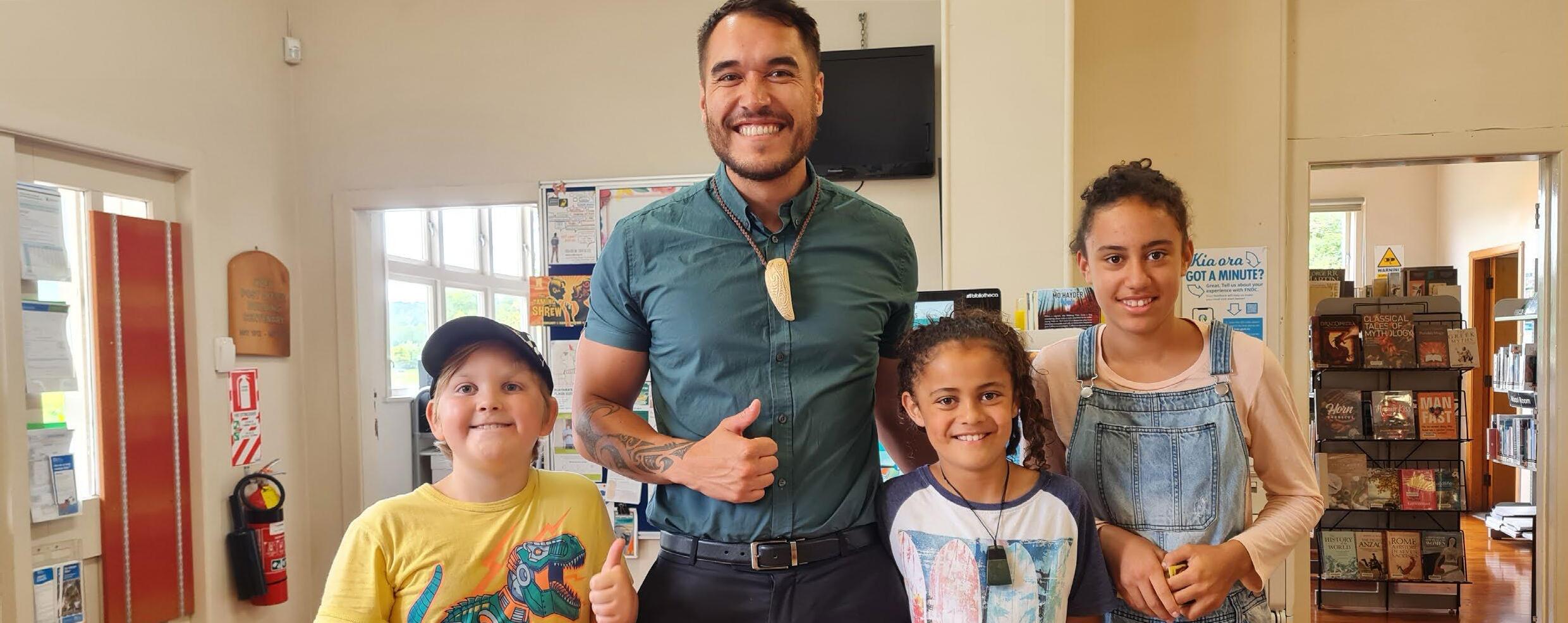
Over summer the Far North District Libraries ran their Raumati Toa Summer Legends, a version of the traditional reading programme. Ange Simonsen tells us about this new initiative.
Usually, we would run our summer reading programme the same way as many other libraries in Aotearoa, starting in December and finishing at the end of January. However, we usually get low engagement in December as many families are busy with Christmas preparations and the end of the school year. To change our outcomes, we ran it from January 8 to February 29 this year.
Our focus would normally be on reading logs and completion rates, but we changed it to focus on engagement in our awesome spaces, with a bit of reading still included. To make it extra engaging, Raumati Toa was designed as a districtwide programme. This included
quests to visit our Far North iSites, Te Ahu Museum and Archives, and even Mayor Moko Tepania joined in the kaupapa by giving out cards to tamariki who managed to find him anywhere in the Far North.
A HUGELY SUCCESSFUL PROGRAMME
The programme proved hugely successful, with over 450 Welcome Packs picked up from libraries across the district. Each Welcome Pack represents a child or family who took part, and while we do not have actual attendee figures, the number is estimated to have exceeded 1,200. This is far higher than our previous engagement over the summer holidays.
The programme targeted tamariki aged between 8-12 years. However, we found that tamariki as young as five and rangatahi over 12 years were taking part in the quests – and
dads were particularly wellrepresented!
Over Raumati Toa’s two-month run, we saw a significant increase in community members coming into our spaces, in complete contrast to previous years. We find that January and February are quieter for us due to the Far North’s great weather and the community being outside enjoying holiday time with whānau. Te Ahu Museum and Archives reported a 168% increase in numbers coming through their space this summer period. And it didn’t end there – new families are joining us as the word spreads that our libraries are welcoming, vibrant spaces where cool free stuff happens!
HOW THE PROGRAMME WAS DELIVERED
The main goal for the tamariki was to collect a full set of trading cards. There were 15 in total,
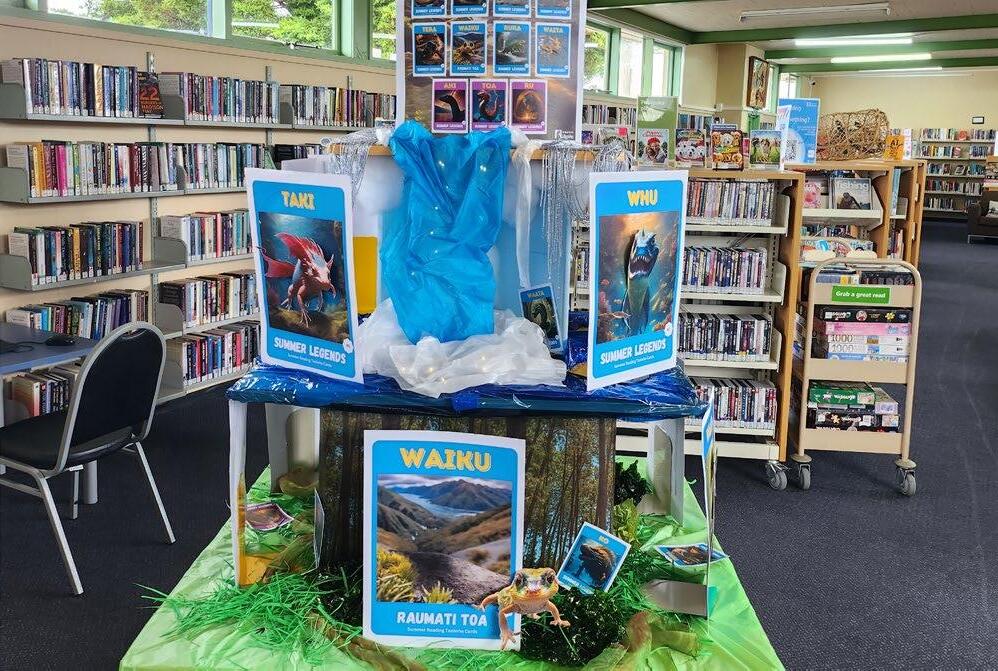
with cards being either blue or purple, depending on rarity. In total, 3000 cards were printed and each of the cards was enclosed in its own ‘mystery’ envelope to add to the surprise! To collect the cards tamariki had to complete a quest. There were 10 different quests, such as drawing a Taniwha’, visiting an iSite to find out about a local spot, and having a kōrero with the Mayor. The excitement on the children’s faces as they unwrapped a RARE card was truly special! We also noticed how siblings were competing and swapping with each other to try to collect a full set. Nothing like some sibling rivalry to encourage participation!
We held themed programming on myths and legends throughout the holidays and continued this once school returned in February. Any attendance at a library programme meant another card! The Far North Library teams held swap meets as part of our regular after-school programming, where families could participate in the activities and swap their double-ups for
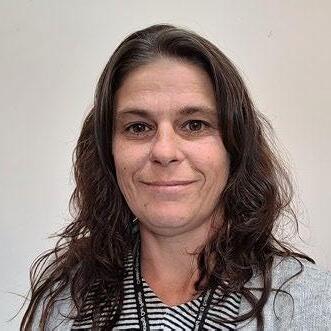
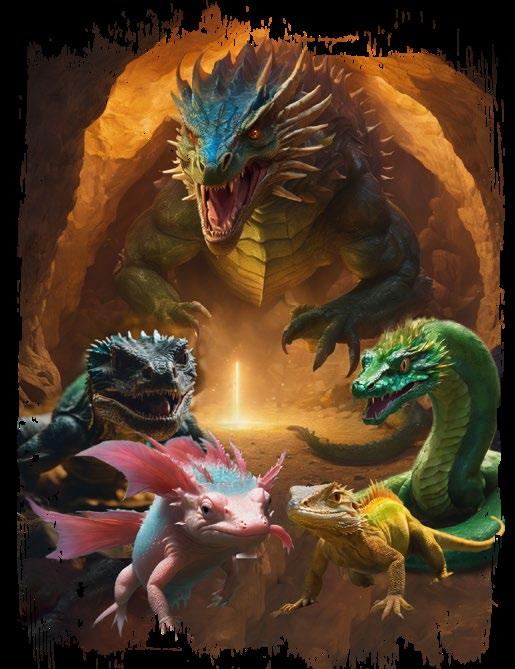
the cards they were missing. We found out that we had some tamariki who drove very hard bargains with our staff, which added to everyone’s enjoyment. There are now quite a few complete sets floating around the district with some children popping them into special trading card covers.
Conversations were held in the libraries between staff and participants about what they were reading. These were far more informal than the scheduled check-ins and it was far easier to engage with the children and parents in this context as tamariki didn’t feel overwhelmed, pressured, or shy. We had families who travelled around the district to each site to find out what quests could be completed. Feedback from these families has been positive, and the question on all their lips has been, “So… what are you doing next year?” Some of the Tamariki have put forward ideas of their own on what the next set of cards should look like, which we take as a sign we’re clearly onto a winner!















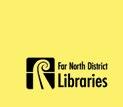

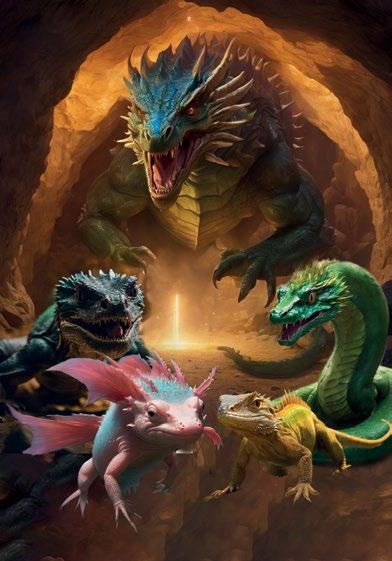
WHAT COULD BE CHANGED
If there was anything we would like to change, it would be the length of time of the programme as it felt like a long run by the end of February. Next year, we would like to trial a six week programme and give a bit more thought at the design stage on collecting data to tell the story of the programme’s achievements and outcomes. One other goal would be a community fun day where a library card could give children free access to a day out that normally might be beyond the reach of some families.
Raumati Toa was devised by Ange Simonsen, Team Leader for Kaitaia and Kaeo Libraries, with support from Whina Te Whiu, Manager for Te Ahu Museum and Archives. Far North District Libraries are happy to share their collateral for this programme with libraries across Aotearoa New Zealand.
Angelique (Ange) Simonsen is the Team Leader for Kaitaia and Kaeo Libraries. Angellives in Kaitaia, having recently moved from the South Island. She is passionate about seeing tamariki engage with our spaces, as she truly believes “it takes a village”.
IT TAKES A VILLAGE: BOOKS, SCHOOLS, AND READING CULTURE

This READ NZ Te Pou Muramura article has been republished with their permission. In it they ask what helps to keep reading at the top of the BAU list for busy schools and kura.
If you’re a follower of our work, you’ve seen that in 2023, we moved away from our classic children’s reading challenge to offer a reading challenge for teachers and school staff (you can read more about why here).
The Teachers Reading Challenge was a hit, with 1,151 school staff participating from 151 schools, 7,240 books logged, including 1,666 NZ books, and over half a million pages read. Generous publishers sponsored a range of prizes, and almost half of the participants also engaged
with our teaching resource for Aotearoa NZ books.
One of the teachers was Farrah Chavez from Mount Roskill Grammar School. MRGS won the overall prize, and Farrah also took out the ‘reviewer’ prize for both the quality and quantity of reviews submitted.
The twist? Farrah is not an English teacher; she’s a digital technology teacher. We often see these two fields as mutually exclusive. But instead of seeing reading and digital technology as incompatible or diametric, Farrah is working to bring them together in the classroom.
“Digital technologies are rapidly changing. Unless students learn how to read technical documents and get acquainted with historical literature to
understand how past innovators and engineers tackled a problem, the knowledge they learn in school might not be enough when they start working,” Farrah points out.
Her experience with the Challenge was largely informed by her passion for her students’ lifelong learning. “Because the reading challenge was for our ākonga, I focused on reading books that will have a positive impact on them. And if I model good reading habits, starting with the Teachers Reading Challenge, my students will continue to learn through reading even after they finish my class.”
It’s heartening that so many teachers—and so many teachers well outside the confines of the English classroom — are
actively working to engage students with reading for pleasure. The classroom is the first and perhaps most obvious community of readers highlighted by the challenge. But it’s not the only one.
A surprising learning from the Challenge was the extent to which teachers, librarians and school staff, too, are seeking communities of readers. We expected perhaps a few hundred teachers to engage with the Challenge in its first year, but instead reached over a thousand. 100% of those who fed back to us indicated that they’ll take part again next year, and a key point of feedback was the desire for a greater ability to engage with each other’s reading and reviews via the website.
We asked Farrah what was behind her drive to review titles in a way that would be useful to other teachers.
“I was inspired by reading the Featured Reviews on the website. When I saw how other teachers are recommending books based on themes and how it could help students, I started reading as if my review can help another teacher with recommending books to their students.”
While teachers around the country flocked to log their reading on the Challenge site, a variety of offerings were also available for keen readers from schools or the public. A good example is the Wellington City Libraries’ Summer Reading Adventure, available to keen participants of all age groups. The school prize for this competition was won by Seatoun School, with 45.9% of their school roll (169 students) taking part.
Wendy Bamber, the school’s librarian, notes that the reading culture in the school is very much down to a whole-village approach.
“We have a terrific reading culture! Our Board, SLT, staff and parents support the library, and teachers bring their classes to visit every week and this time is valued and prioritised. Children are given regular, autonomous access to a strong, up to date collection with a wide variety of books. We devote time to book-talking and other ways for children to recommend books to each other and I love nothing more than being asked by children for guidance and suggestions.”
Callum Gray, the Head of English at Mount Roskill Grammar School, describes the buzz present in a school with a strong reading culture: “I know many teachers display posters in their classrooms or workspaces that describe what they’re reading. Many also have bookshelves in their rooms and supply books to students themselves. From the administration block to SLT to department work rooms, you can hear people talking about what they’re reading.”
Just as a classroom or a group of teachers can form a community of readers, so too can a school. But it’s vital that engagement occurs at all levels, from the student browsing the library right through to the Board and Senior Leadership Team, and eventually also through to parents, as Wendy notes.
“A recent initiative to invite parents into the library for a Reading Cafe to read with their children had very high engagement and shows that our parents support reading too. Our staff embraced the recent Teachers Reading Challenge and we often share books amongst ourselves. I think showing reading for pleasure as a valid use of time is important for both staff and parents to role model.”
Teachers are hungry for new titles to teach, to discuss, to lend, to simply have present in the classroom, and one of their greatest resources is each other. 44% of the teachers who participated in the Challenge said that it helped them find texts for the classroom, and we hope to continue to foster these networks of recommendation.
We hear many tough statistics about the state of reading. But what about the positive ones? The latest iteration of the Growing Up in New Zealand report, released by the Ministry for Culture and Heritage, notes that three of four of the 12-yearolds studied are reading outside of school at least once a week. Reading is still a significant activity, celebrated and loved by many young people. But how do we keep it that way?
What’s the secret component to growing readers, then? It turns out that the answer might lie not with one single person but with everyone. Not a sole classroom or library, but many communities. It takes students, teachers, school communities, and parents together. It doesn’t even just take a village, it might take many.
A CELEBRATION OF RECENT MĀORI AND PASIFIKA BOOKS
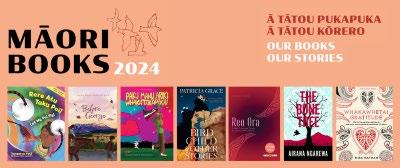
Alongside the dancing, food and festivities at Auckland’s iconic Pasifika Festival this year were more than a few good books. The 90-plus titles featured in The Coalition for Books’ Pasifika Books and Māori Books | Ngā Pukapuka Māori catalogues were out on display and for sale. The idea was to take books to communities in places outside the usual settings — and the crowds of people at Pasifika were on board. Attendees browsed and bought a huge range of books from On Call, Samoan-New Zealand surgeon Ineke Meredith’s sharply observed memoir, which opens the doors to the operating theatre and the writer’s life, to bilingual picture book Rere Atu Taku Poi! Let My Poi Fly a story about gender fluidity, self-expression, cultural pride and having the courage to do what you love by poi expert and lecturer Tangaroa Paul, who identifies as gender fluid.
It's the second year The Coalition for Books has had a physical presence at Pasifika alongside the Dorothy Butler Children's Bookshop. Since 2020, The Coalition has collaborated with publishers and writers from around the motu to gather an annual showcase of Māori and Pasifika books. The global
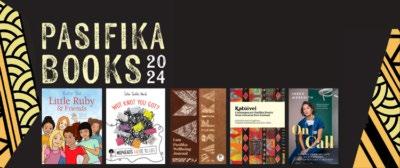
pandemic in the first few years meant these were online only, promoted digitally via our Kete Books website. These catalogues have grown each year with the number and range of books submitted. In 2024, the catalogues bring together recent and forthcoming books from 22 different publishers, reflecting the strength of Māori and Pasifika writing and publishing and the appetite of readers to engage with these works. The two catalogues produced this year are packed with titles by Māori and Pasifika writers, illustrators, editors and translators and a few books on Māori or Pasifika themes or topics by non-Māori or Pasifika contributors too.
Featured titles in Pasifika Books 2024 include the new eviscerating and consoling poetry collection from Tusiata Avia, Big Fat Brown Bitch (read Avia's poem 'Ode: don't punish the wealthy' here), Selina Tusitala Marsh's Mophead workbook Wot Knot You Got?, and A Canoe Before the Wind, the memoir by Aotearoa's first Samoan Police Commander Vitale Lafaele.
Publisher and author Dahlia Malaeulu's bilingual books for children are also present.
Malaeulu has collaborated with Mele Tonga-Grant, Inangaro Vakaafi and Sale and Selina Alefosio to create Tongan, Niuean and Tokelauan editions of the Mila's My Pasifika series titles. Malaeulu's collection of perspectives from Pasifika families living with autism spectrum disorder, vĀsifika, also features. Other titles include Gina Cole's Na Viro, a Pasifika Futurism novel (a genre Cole has defined), Pacific Arts Aotearoa, edited by Lana Lopesi, tells the story of the legacy of Pacific Arts in Aotearoa, giving artists' perspectives and Damon Salesa's essays on the histories of our Pacific World, An Indigenous Ocean.
The Māori Books | Ngā Pukapuka Māori 2024 catalogue is in both English and te reo Māori. Featured adult fiction includes Airana Ngarewa's best-selling The Bone Tree (reviewed on Kete here) and Patricia Grace's new collection The Bird Child and Other Stories. In her review of The Bird Child for Kete, Jade Kake writes the stories are "rich and immensely readable". She also writes about Grace's use of te reo Māori and the importance of this in the normalisation and reclamation of the language. Kake's own work is present in
the catalogue. Her 'organic and conversational' tribute to the late architect Rewi Thompson, co-written with Jeremy Hansen, features as does her novel Checkerboard Hill, a debut Vaughan Rapatahana has described as "impressive' and 'painted as much as penned".
Te Awa o Kupu, Hiwa and Huia Short Stories 15 are among the poetry and short stories collections. Koe, a forthcoming anthology of environmentally themed poems selected by Janet Newman and Robert Sullivan, is here too. Books for kaipānui tamariki or younger readers include Deborah Robertson's novel Before George, set against the backdrop of the Tangiwai
disaster and Tim Tipene's Te Pukapuka ka Kore e Pānuihia (The Book that Wouldn't Read), which has design elements to appeal to reluctant or dyslexic readers.
There is a rich set of nonfiction titles too, from books on art and arts practice like Ngā Kaihanga Uku: Māori Clay Artists to collections of writing like Ngā Kupu Wero edited by Witi Ihimaera to books like Hira Nathan's Whakawhetai Gratitude.
It's likely that one of the non-fiction titles in these two catalogues will be this year's General Non-fiction Award Winner at the Ockham New Zealand Book Awards.
An Indigenous Ocean, Ngātokimatawhaorua, and There's a Cure for This are three of the four books shortlisted.
You have to imagine that there might be a book for every reading interest in Pasifika Books 2024 and Māori Books | Ngā Pukapuka Māori 2024.
Printable versions are available here and here .
Gale OneFile: Australia and New Zealand

Powered by Gale’s authoritative and continuously updated reference material and focused on an Australian and New Zealand perspective, our user-friendly database organizes over 850 full-text publications including ANZ periodicals, magazines, academic journals, ANZ news articles, images, videos and audio files including video & full-text content from the Australian Broadcasting Corporation. Gale OneFile: Australia and New Zealand is included in all Gale EPIC subscription packages or available directly as a standalone subscription.
Contact your Gale Account Manager for more information, pricing or to arrange a 30-day free trial.
Elise Baldwin Gale New Zealand Account Manager +61 439 772 155 elise.baldwin@cengage.com
ANOTHER LOOK AT DIGITALPASIFIK
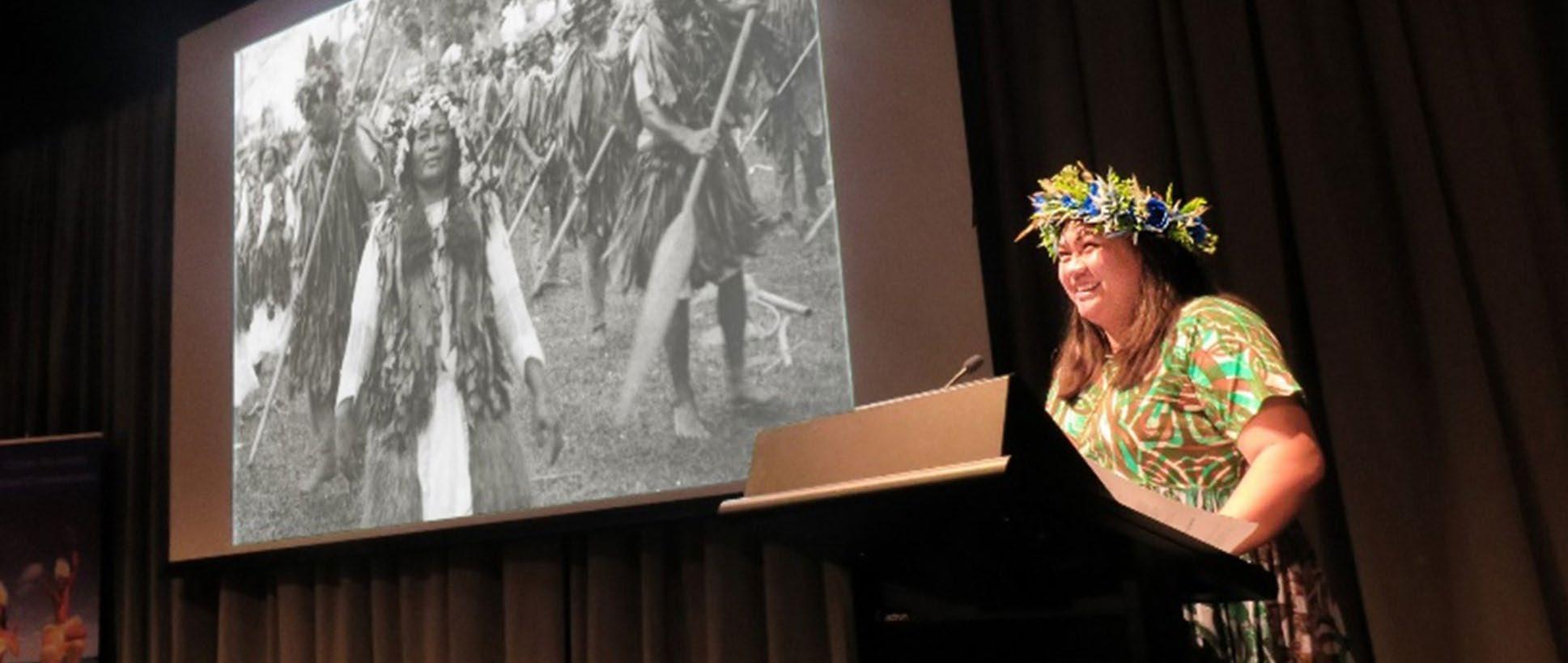
Digitalpasifik is a website that makes Pacific heritage and culture visible and accessible. It shares Pacific collections from galleries, libraries, archives, museums, tertiary institutions, the media, and Pacific communities. These collections can be found on digitalpasifik.org. Library Life talked to DigitalPasfik in 2021 and again this year to see how their project has progressed.
Digitalpasifik is part of the Pacific Virtual Museum, which was started in 2020 with funding from the Department of Foreign Affairs and Trade in Australia. It was set up by the National Libraries of New Zealand and Australia.
The site's main objective is to ensure Pacific people have access to and visibility of their heritage. Many Pacific people may not know these collections exist or are unaware of where they exist. The hope is that now that they are visible and
accessible, people can find connections, learn, and share knowledge of the collections they hold.
“We see ourselves as a bridge between the holders of the collections and the holders of knowledge,” says Taputukura Raea, Programme Manager for the Pacific Virtual Museum.
“Because the website is for people in and of the Pacific, we wanted it to be accessible to them. When we started developing the website, we didn’t want it to chew up all your data. Data can be expensive in the Pacific, so we ensured each page was under a megabyte. We also know internet speed is variable in the Pacific, so we developed the website for 2G and 3G bandwidths.”
The website is easy to navigate and designed so that anyone of any age, including elders, can use it. Much of the user testing was carried out in the Pacific.
“One piece of feedback from our user testers that her grandmother, who can speak English but can’t read it. So, we used more iconography on the front page so anyone could navigate.”
The site has a user contribution feature. This allows users to share their knowledge, memories, and experiences and identify people in the collections. It is also a way for users to correct inaccurate content and for content partners to learn more about their collections.
“I have found the user contribution to be the best part of our website – seeing how our users connect to our collections and the interesting stories that come through. It helped me learn about my own family. By sharing the collections with my parents, we have found family members. This has sparked stories about our family that I hadn’t heard before.”
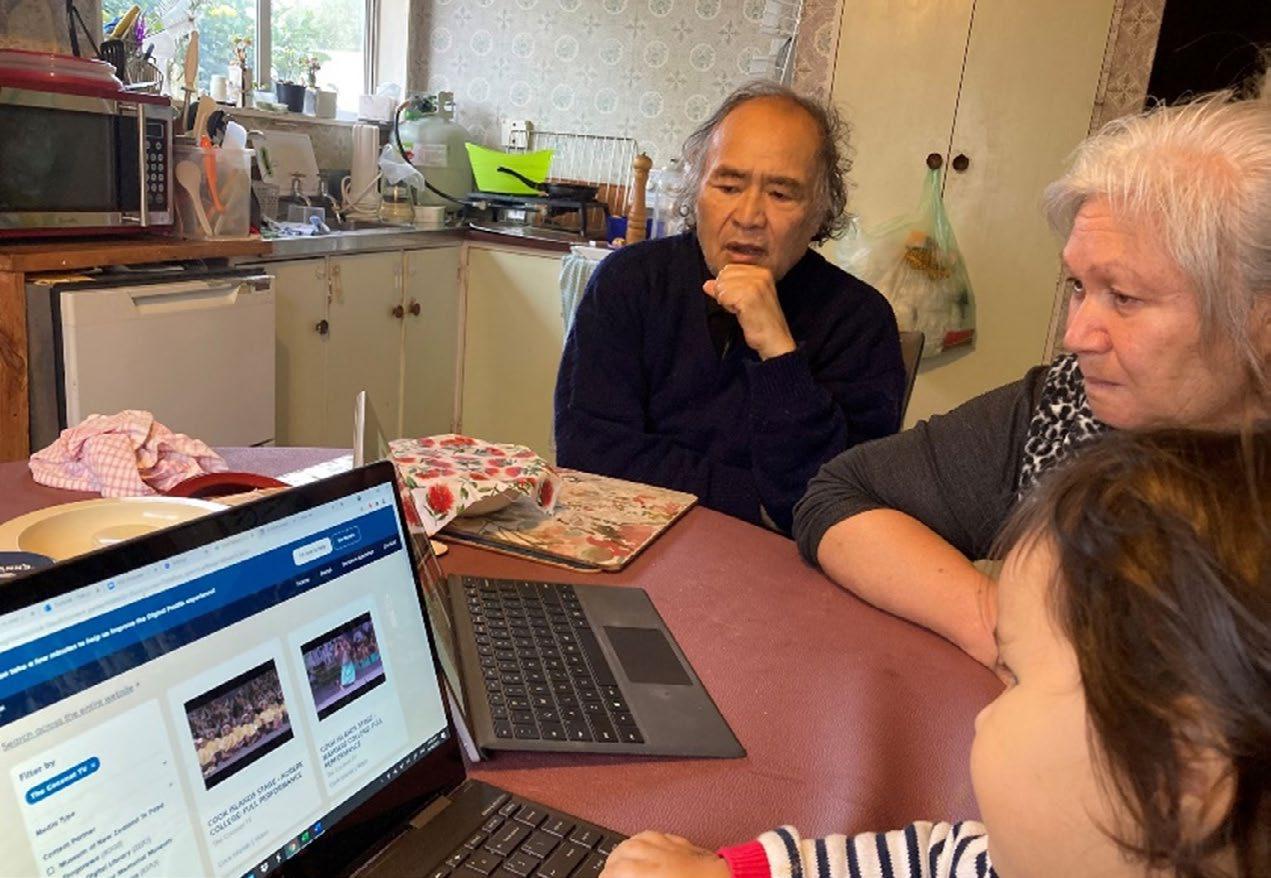
There are currently 876 content partners sharing over 500,000 records on the site.
A key part of this project is engaging and creating relationships with cultural heritage organisations in the Pacific. This was difficult when COVID hit and couldn’t be done while the borders were shut.
The team connected with Pacific colleagues through Zoom webinars and Facebook live events. This allowed virtual visits to these museums and libraries to explain their collections.
“We tried to make this as simple as possible for Pacific institutions so that if they had a cell phone and internet connection, we could host them. The first webinar was with Tuvalu National Library and Archives, who took us on a tour of their collections and Siaosi Finiki shared stories and memories of life on Tuvalu.”
A second attempt with the Solomon Islands Museum had 40 eager people on the Zoom call wanting to see and hear more about the museum.
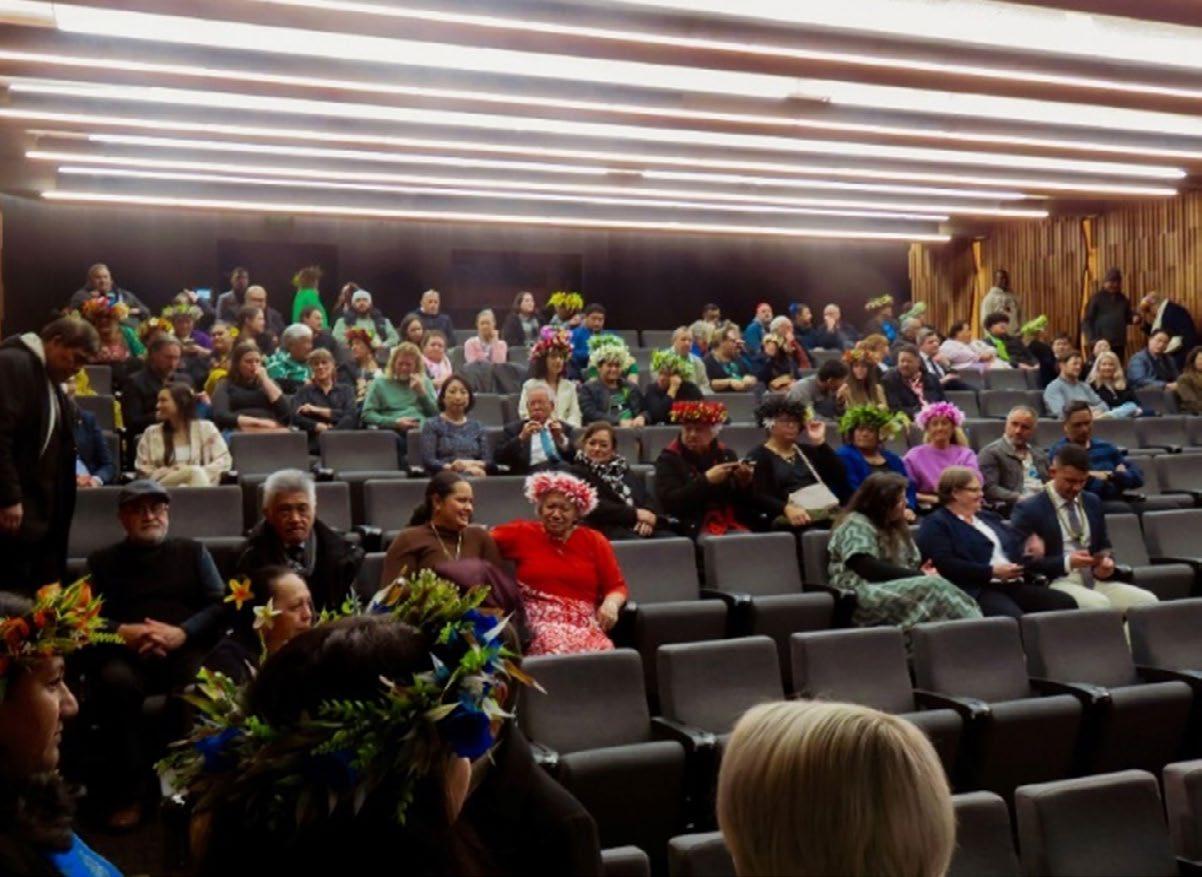
Unfortunately, the internet cut out in the Solomons, and the collections tour had to stop. These are just some of the challenges they face in the Pacific.
“We wanted to make sure we could highlight their museum and collections, so when ABC International approached us to see if we knew of any Pacific organisations they could promote, the Solomon Islands Museum was the first on our list. They were able to create an insightful promotional video for the Museum. Although we couldn’t host on Zoom, ABC Australia could do this on our behalf, which you can see in this interview here.
In 2023, an event was held in collaboration with Nga Tāonga Sound and Vision, National Library of New Zealand, Archives New Zealand, and the Cook Islands High Commission. 'Po teata o te Kuki Airani' was a Cook Islands movie night celebrating the Cook Islands constitution. It was a way to share Cook Islands Archival footage from the early 1900s to 1965, when the Cook
Islands became a state in free association with New Zealand. The films helped the audience from the Cook Island community and diplomatic corps travel back in time to learn about Cook Islands history and culture.
The team has travelled to the Pacific and visited the Cook Islands, Solomon Islands, Commonwealth of the Northern Marianas, Fiji, Samoa, and Palau. On these trips they have promoted the website and engaged with content partners.
“The visits were useful in understanding the challenges our Pacific colleagues deal with. We have learnt that it is very difficult for them to share their collections online. They often don’t have the resources and staff to do this. On returning our developers created a function so they could still be a part of the project. A catalogue-only feature allows those institutions that only have an Excel spreadsheet of their collections to share their meta-data on our platform. So even though you might not be able to see the full record, you can still see that that collection exists.”
THE NEW ZEALAND LEGAL INFORMATION INSTITUTE
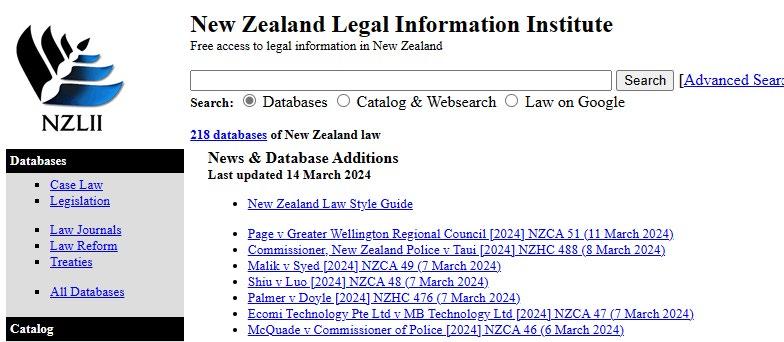
New Zealand Legal Information Institute (NZLII) is a free online database of unreported New Zealand Court and Tribunal judgments used by legal and library professionals in Aotearoa and worldwide. It is a joint project of the University of Otago Faculty of Law, the University of Canterbury, and the Australasian Legal Information Institute (AustLII). AustLII has provided technical services and infrastructure since NZLII’s establishment in 2004.
“Our strength is that our information is anonymous and free,” says Judi Eathorne-Gould, NZLII Manager. Judi has degrees in law and history.
“We convert documents into HTML to be searchable and used without downloading a whole PDF. Our site might be ugly – it hasn’t changed since
2004 – but it loads quickly, and we don’t have the money to spend on fancy design. We’re here to provide this information for free.”
People are finding the information they need on NZLII and the number of visits shows this. In 2023, there were 34 million site visits to the 218 databases containing 565,000 documents. NZLII holds the only digitised versions of some legal documents.
The NZLII is part of the Free Access to Law Movement (FALM), an international voluntary association with members from over 60 organisations worldwide. FALM members provide and support free access to legal information consistent with the movement's principles and subscribe to the Declaration on Free Access to Law to promote justice and the
rule of law. Free and untracked information is a major principle of the FALM.
However, NZLII’s existence is precarious. The Institute relies on donations and grants, and there is concern that it would be vulnerable without secure funding and support. If it were to collapse, there would be a significant gap in the availability of critical information widely accessed by the legal profession, libraries, members of the public, and government.
“The New Zealand Council of Law Reporting is our biggest funder, and we would not be able to exist without them. We use our other donations to support our operations and to update the database, which we employ law students to do. We are extremely vulnerable, and our donations are majorly down this year.”
While funds cover some of the staff contributions, extra funds would allow more paid hours for contributing additional material to NZLII for the benefit of all. NZLII are open to suggestions and donations to allow this.
The site also contains material of interest to non-lawyers –particularly the historical and genealogical information in the Government Gazettes and Book of Awards.
Most case law in New Zealand is tied up in subscription sites such as LexisNexis and Thompson Reuters.
“These are expensive sites, and many law firms, provincial lawyers, and members of the public can’t afford to subscribe to them. NZLII access helps to keep legal costs down and allows self-supporting litigants access to free information to support themselves.”
While the technical base is in Australia, this is a New Zealand-
branded information source. Good data relationships have been established with different data providers, such as the Ministry of Justice Tribunals Unit and the Parliamentary Counsel Office. New relationships are being developed, such as the Wellington City Council, as District Licensing Committee decisions must be available to the public. In 2023, the DLCs on NZLII received over 2 million uses.
“If I could afford to do it, I would pay someone to fix the database so we can display macrons correctly—this is a coding issue. The Government Gazettes get five million views a year. If we had more funding, we could add other historical gazettes onto our database - they have been scanned, but we do not have the resources to add them to the site.”
Supporting better access to free legal information could see the Institute providing more guides on the court system, information
that would be easily understood by the public. It could also see the uploading of anonymised decisions by the Tenancy Tribunal and guides for tenants and landlords.
“People use us because they know we are anonymous, not tied to government, and free. We can’t be everything on this level of funding support though.”
If you are interested in donating to this service, you can go here:
• For credit card NZLII or by direct deposit (this is a link to a PDF form that can be filled out and emailed to NZLII but also includes the direct deposit information).
LIANZA is working with the New Zealand Law Librarians Association in their attempts to find secure and sustainable support for the NZLII.
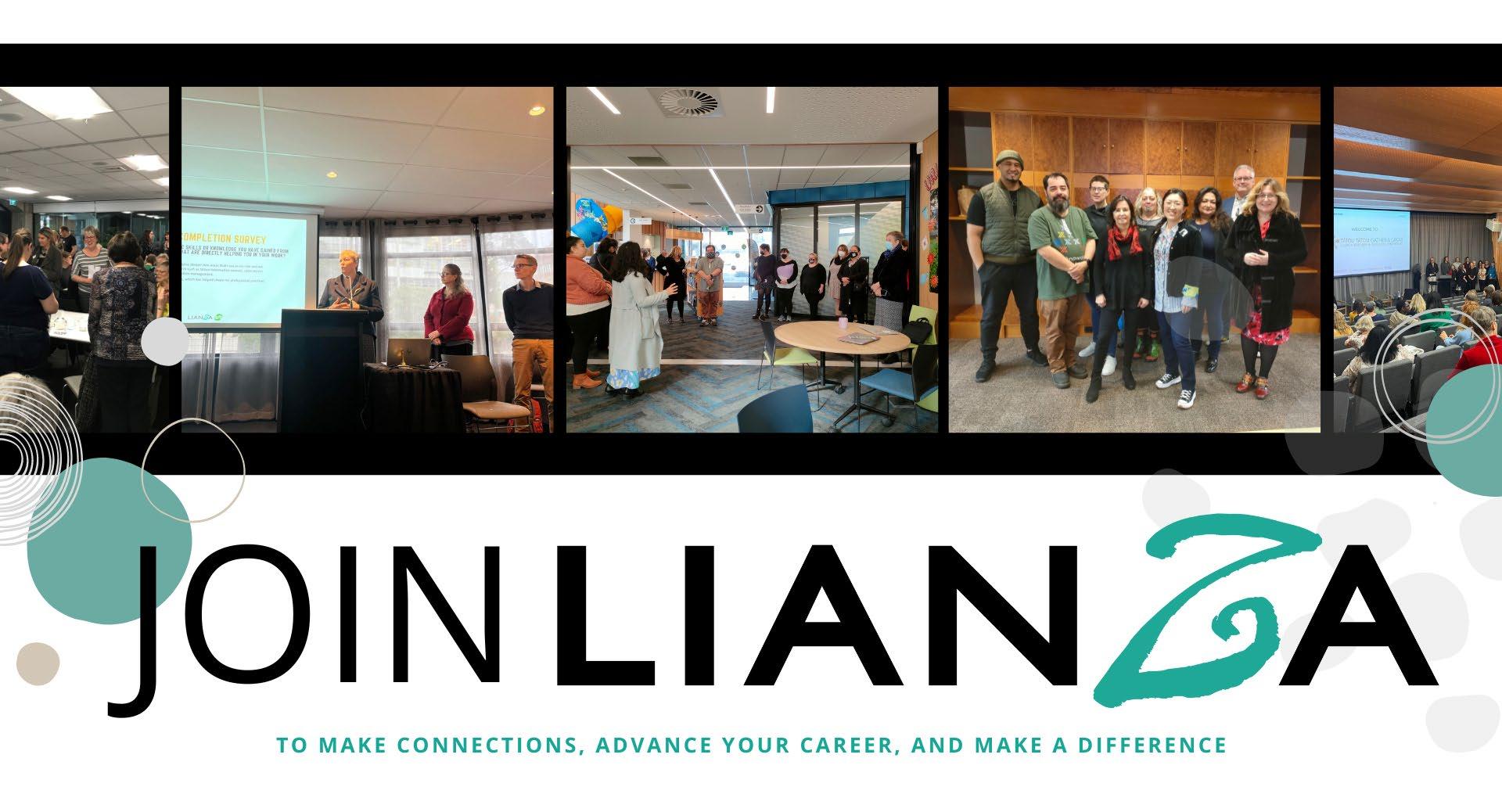
LIBRARY MAHI

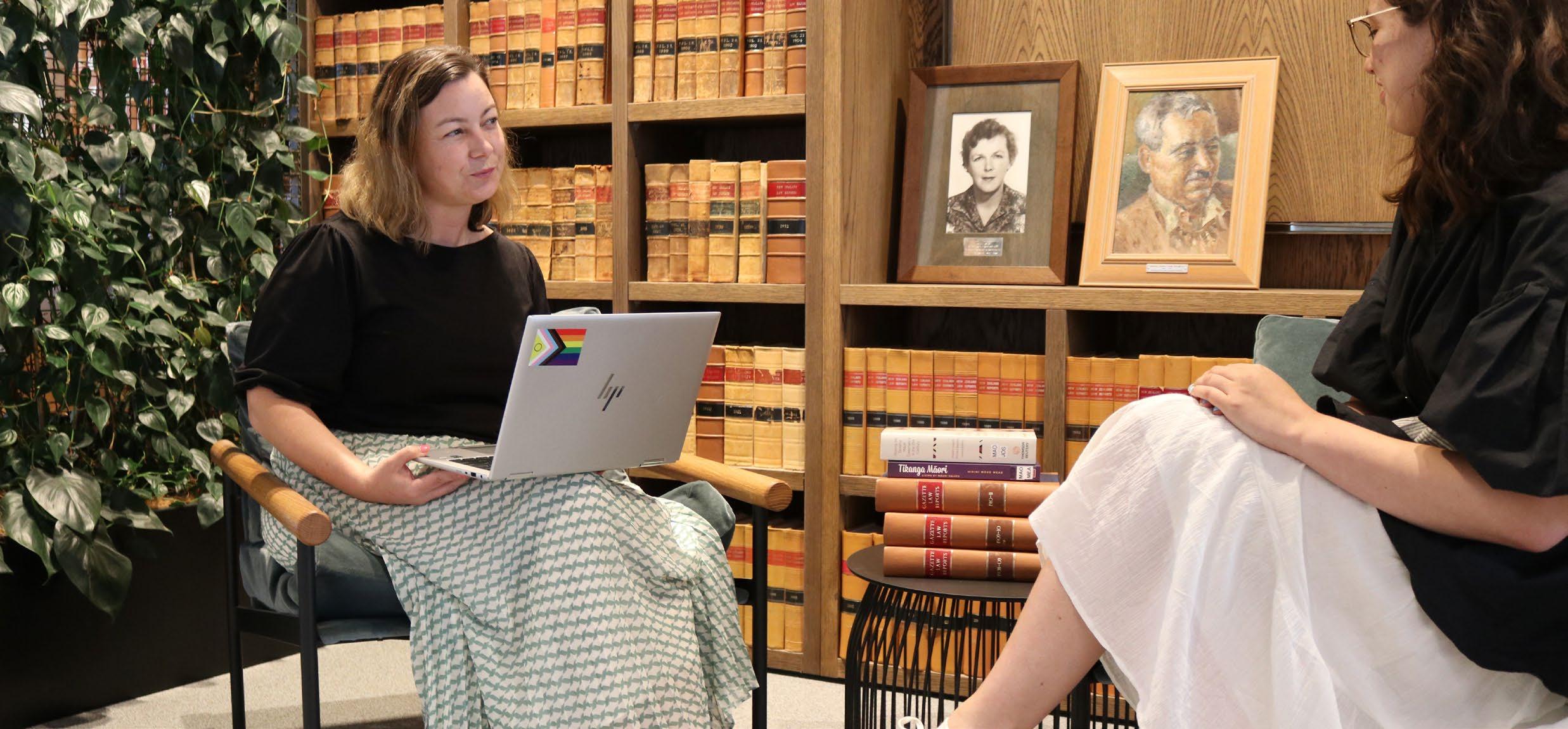
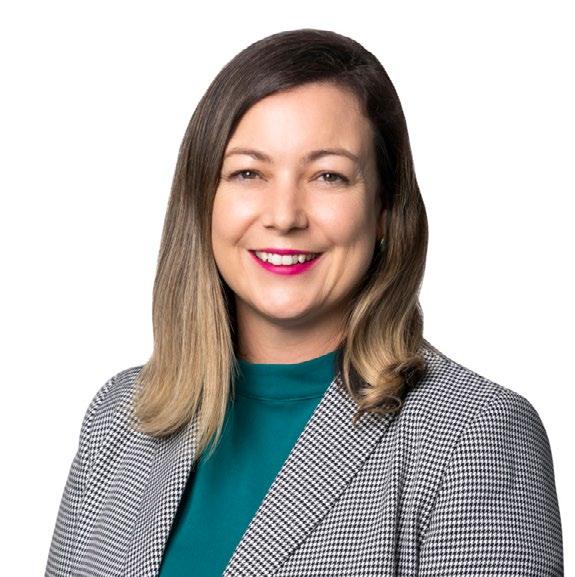
ERIN CAIRNEY
Erin Cairney is the Knowledge and Information Manager at MinterEllisonRuddWatts and the New Zealand Law Librarians Association president. Erin talked to LIANZA’s Angie Cairncross about being a law library and information specialist.
Erin has worked in law libraries for over 20 years and studied through the Open Polytechnic, completing her Bachelor of
Applied Science Information and Library Studies in 2004.
“Completing diplomas along the way was a great stepping stone and a way to see if that was the path I wanted to take at the start of my studies.”
As a lifelong learner, Erin has certificates in records management and an introduction to law paper. She regularly seeks out professional development opportunities.
People learn on the job in specialist library settings, says Erin. So, you don’t necessarily need law qualifications. But the paper she did consolidated what she had learned in her first five years in a law librarian role, so it was useful.
Being the president of the NZ Law Library Association is an amazing volunteer role. “We have about 100 members
working in libraries within law firms, courts, universities, legal chambers, and government agencies.”
In her role at MinterEllisonRuddWatts, Erin manages a small team that ensures the staff in the two offices in Auckland and Wellington have the legal and business information resources they need.
“I manage the budget and several different suppliers, which involves reviewing system use, talking to people about how they are using and getting the information they need and keeping up-to-date with what's happening in New Zealand and globally. Because that impacts the type of legal work that we do.“
New starters and law graduates are trained in using information tools, many of which are
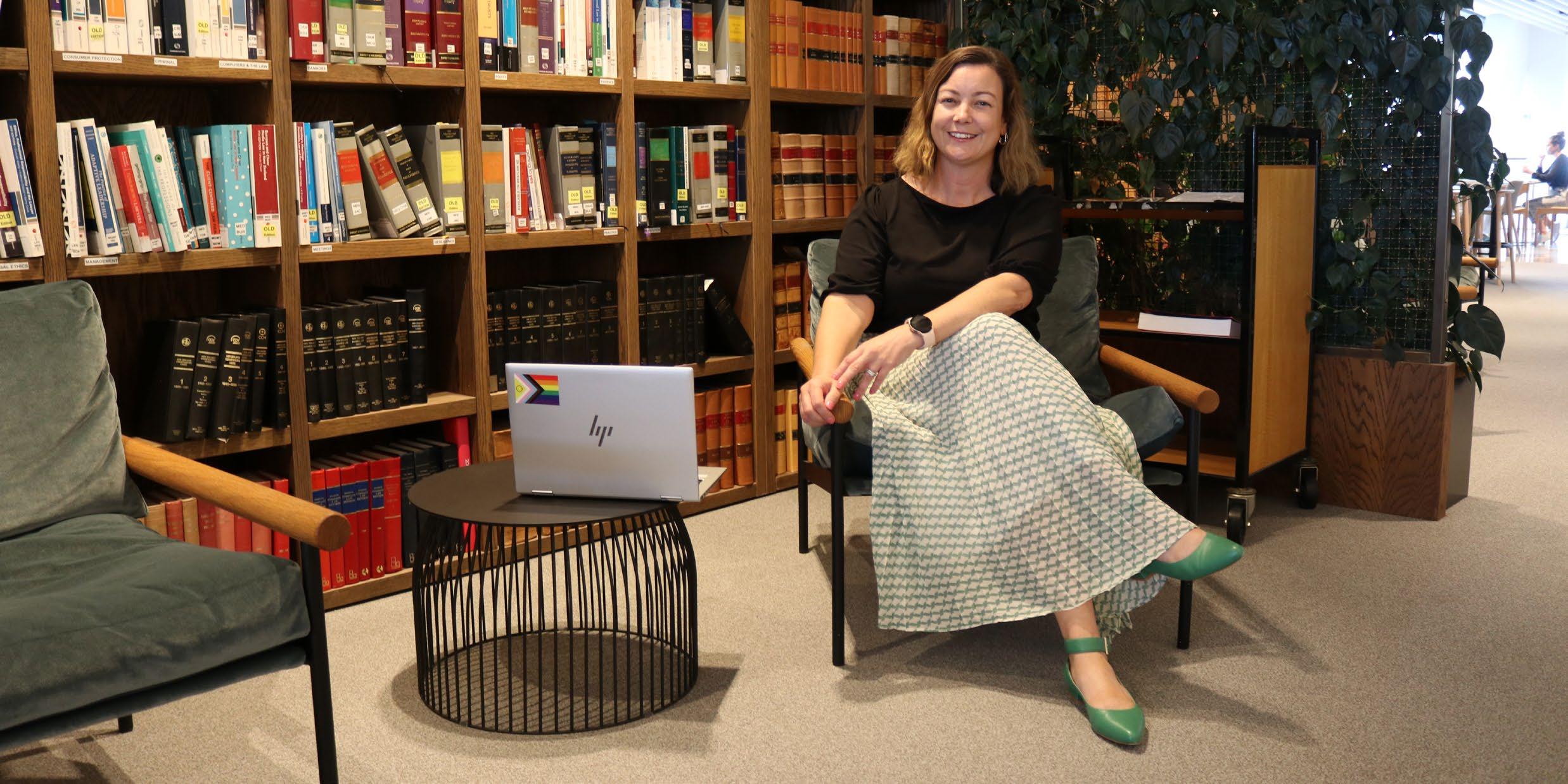
subscription-only. Erin really likes working with people to problem-solve when they have information access issues, or it's taking a long time to get the information they need.
Erin did not plan to work in law libraries. “When I finished high school, I thought I might become a teacher but didn't end up applying. So, I thought I would work for a year as an office Junior.”
After a year, Erin was approached about a library assistant role at the law firm. She asked if she could ditch the mail trolley, which was soon replaced by the library trolley.
“In those days, it was a lot of photocopying and making bulletins with journal-content pages, but I just loved the variety of the work, the questions, and never knowing what the day would bring.”
“I'm always telling people you don't know what you don't know.
So, if you're curious and love news and current affairs, law library and information work could be the place for you.”
While a law library might differ from a public or school library because of its specialised content and confidentiality regarding legal matters, there are also similarities.
“All these libraries are about access to information, building relationships, and working with people.”
When asked what she liked most about her job, Erin said the variety. “You don't know what you'll get asked each day, which might scare some people. The law impacts society and is for everyone. It's dynamic and constantly changing. That's why I've been in law for over 20 years.”
“There’s so much we've got to know—legal tech and generative AI. It makes us look at how we do research, train
people, and validate answers, especially in law. We need to be aware of Tikanga Māori and the courts and the Te Ao Marama framework that is being introduced into courts. And there’s also climate change litigation—law is an interesting sector.”
Erin encourages library and information students or early career librarians thinking about becoming a law librarian to be curious.
“Speak to someone on the NZLLA website. Connect with me on LinkedIn. Attend a LIANZA event, community, or professional development. There are lots of members you can connect with in both LIANZA and NZLLA.”
Watch the full interview on YouTube here.
LIBRARY OF THE ISSUE
ST PATRICK’S COLLEGE LIBRARY
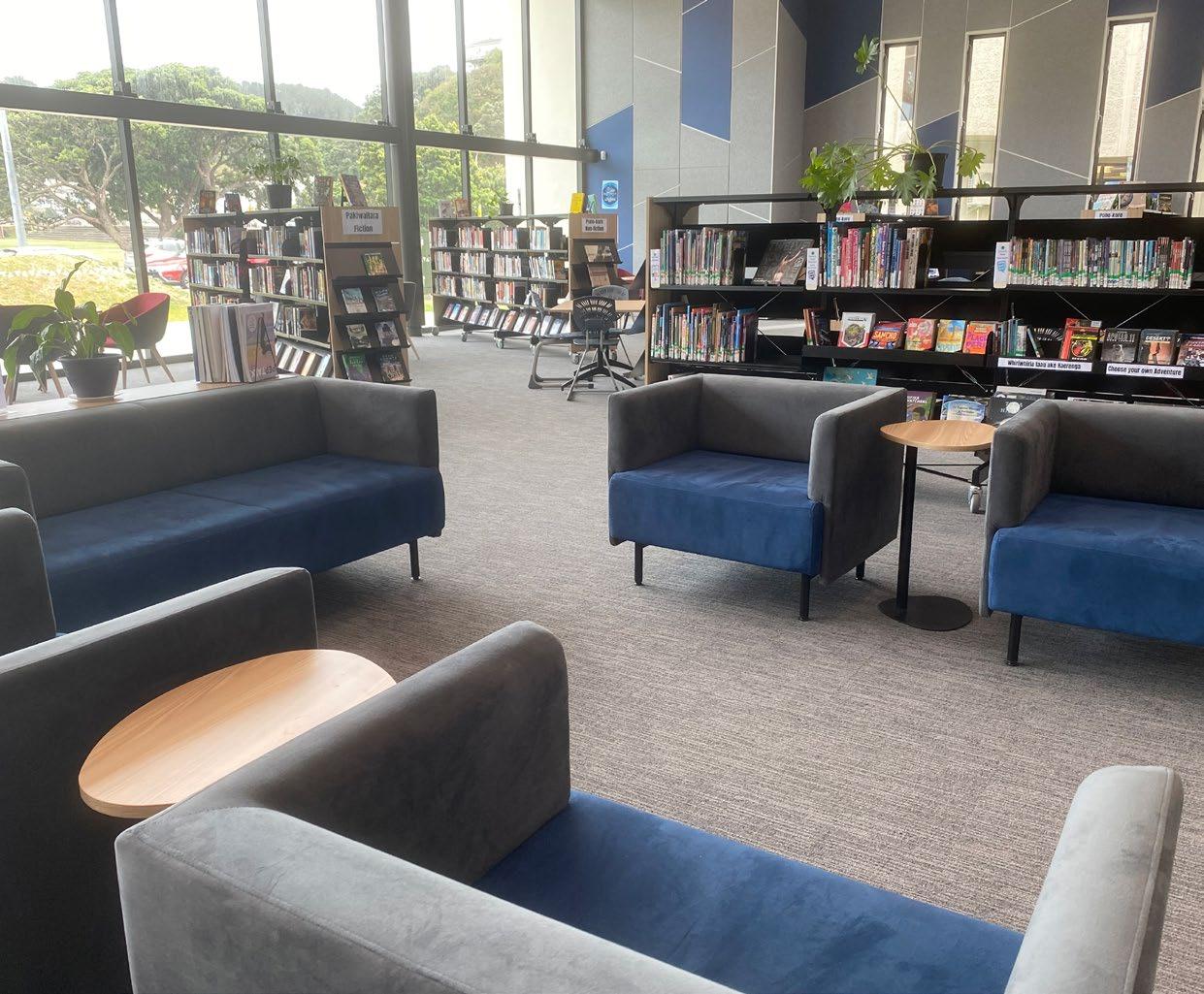
St Patrick’s College Library is a school library catering to 700+ boys. In March 2024, it opened the doors to a brandnew purpose-built space that brought the library into the heart of the school.
The vision of the new learning hub building was to take the school from a classic example of brutalist architecture that almost dared anyone to come beyond the gate to something made of glass and light, allowing the community to feel part of the school.
In my completely biased opinion, using this space to house the library was inspired. After all, libraries are one of the last institutions in our modern world that remain free. Free to enter, free to borrow, free to be yourself. So, what better way to embody freedom in a new design? Unlike the old library,
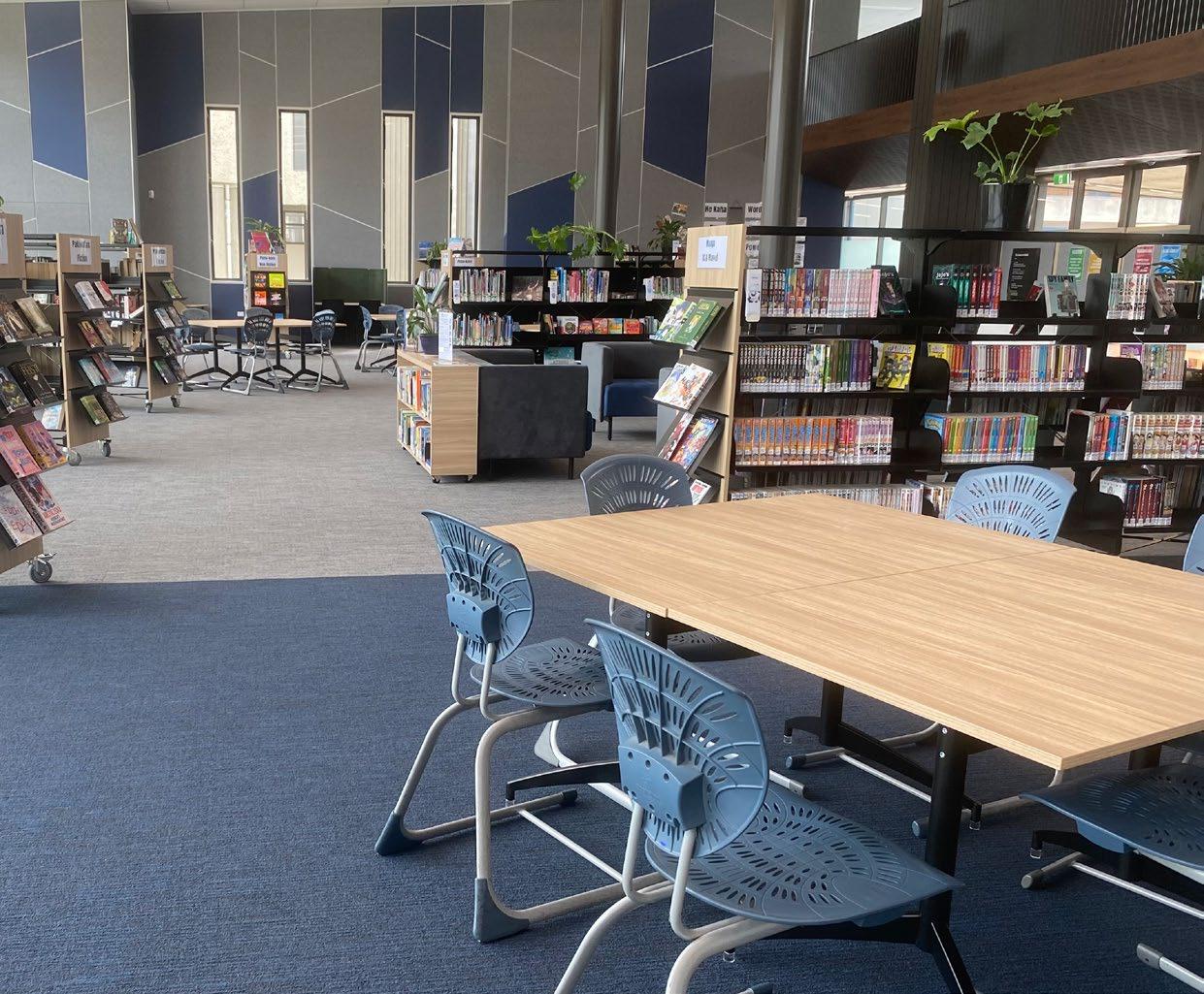
which was tucked out of the way, the new building has brought the library down to the main level, where everyone walks past. The warm, inviting atmosphere and exciting displays entice people in.
With soaring double-height ceilings the illusion of space is immense and all the epithets of light, bright, and airy that epitomise a modern library are realised in a building that succeeds in connecting the school and community.
The challenge for me, as the librarian, was what to do with essentially a large open rectangle. How to create zones that are easy to navigate and cozy spaces amongst the soaring, airy heights. Thinking about the kura and how the space would be used was the most important part of my design process. Like any library,
our biggest zone definition is between fiction and non-fiction. These are now defined by furnishings ― both the shelving and the cozy nooks between them. The fiction bays along the windows have small seating areas, encouraging students to socialise or curl up with a good book. The non-fiction collection, on the other hand, has small study pods at the end of each bay promoting individual research.
Around the library there are also elements of zoning unique to the needs of our kura. For example, the sports section and displays, situated at the entrance, tempt the interest of many of our students. The New Zealand non-fiction books also have their own section adjacent to lockable shelves for rare New Zealand reference items, supporting local knowledge and the new histories curriculum.
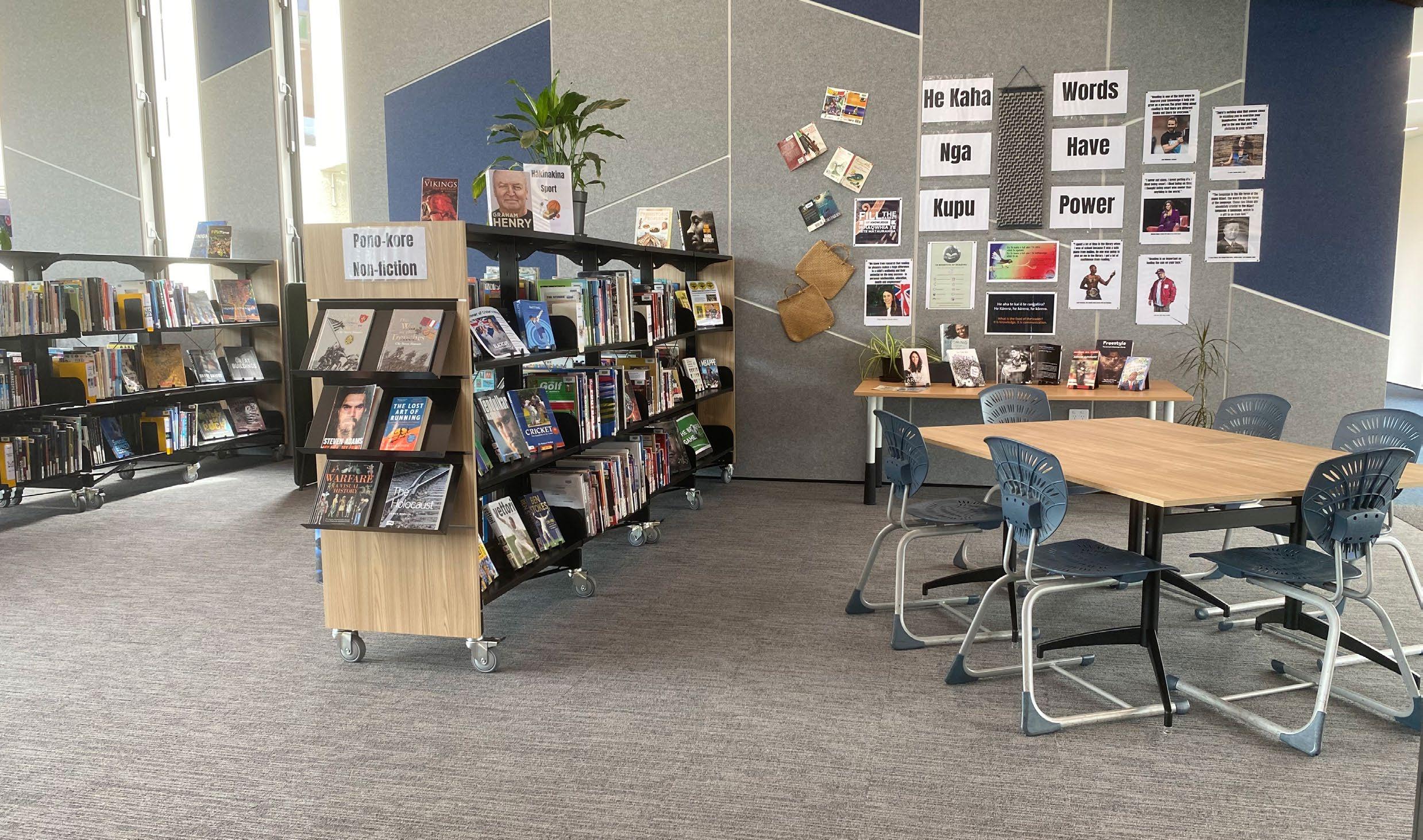
Of course, any major construction comes with problems and pitfalls, and the biggest lesson I have learned is that being a school librarian requires a certain fierceness ― not to be the grumpy, shushing, crotchety old meanie of librarian stereotypes, but to advocate for your students and kura.
Creating a library space inevitably involves many experts. Architects are experts in buildings, while others might be experts in project management. But we must remember that librarians are just as expert in our field. Our expertise should not be forgotten or overlooked.
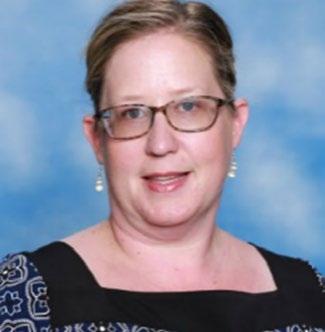
Throughout this project, I worked with various combinations of people in these different roles and saw what a difference those who were open to true collaboration made to the success of the final design. My best advice to anyone involved in a library building project is to advocate for your space and trust that you are as much an expert in your field as all the other experts are in theirs.
As I sit and reflect on the vision to open up a closed and defensive space, the battles won and lost, and the back-breaking work of packing and setting up, I am awed and grateful for what we have created. School libraries
are ultimately about the people. For school librarians, that means the students. They are who we do this for, and when I see the different zones, soak in the joy of all the living plants and books nestled together, giggle at my carefully placed Manga section drawing crowds of students like bees to honey, I take great joy in knowing that I have been a big part of creating something for them that draws the best of the old library into something truly fantastic for the future.
Ellie Nicholson is in her seventh year as Library Manager at St Patrick’s College in Wellington. Originally from a teaching background, Ellie re-trained as a librarian and has never looked back. In 2021, Ellie played a key role in facilitating the successful SLANZA online conference Whakaohooho, and this year, she has taken up a position as Wellington Representative on the SLANZA National Executive.
TERTIARY PROFILE
FROM GHANA TO OPEN POLYTECHNIC | TE PŪKENGA
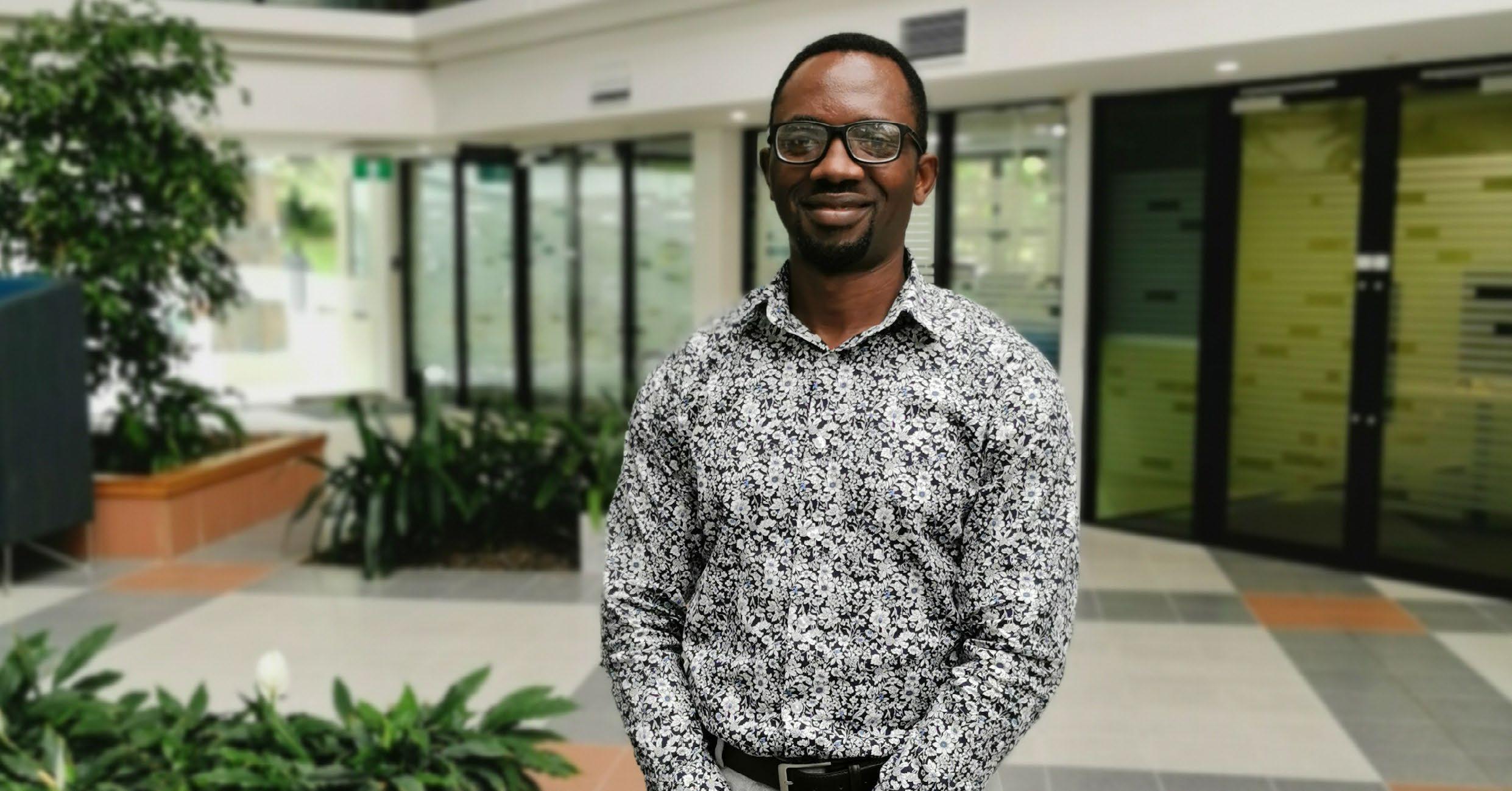
A love of sharing books with others has seen principal academic staff member Eric Boamah travel from his home country of Ghana to New Zealand, eventually becoming degree leader of the library and information programme at Open Polytechnic | Te Pūkenga.
Previously, Eric worked in Ghana as a school teacher where he was part of various school library initiatives, including a readingwithout-books activity he initiated in some Ghanaian rural schools that had no libraries.
This initiative led to some rural schools receiving reading books in metal boxes through a Ghana Library Board and Ghana Book Trust programme for school children.
Eric holds a Bachelor of Information Studies with a minor in linguistics from the University of Ghana. He also has an international Master of Art in Digital Library Learning and a PhD in Digital Preservation and Cultural Heritage from Victoria University of Wellington Te Herenga Waka.
While Eric was doing his PhD, he also worked for the Open Polytechnic as an adjunct marker and in 2013, he started working as a lecturer. He is now the Degree Leader of the Library and Information Studies programme at Open Polytechnic.
Eric enjoys both teaching and research. He always encourages the students he supervises in research projects to publish their projects or apply their research
in real-life situations. Through this initiative, one of the ākonga (learners) Eric supervised used his research project to establish the Zimbabwean Rural School Library Trust (ZRSLT). It collects and ships donated books and educational materials from New Zealand to Zimbabwe to promote libraries and encourage reading in rural schools.
Eric’s current research explores the school archivists' role in maintaining the value of school archives to support the New Zealand school history curriculum.
Being an academic staff member offers him a platform to learn from ākonga and use his experience to guide them to form their learning.
“I believe that people have an inherent need to be understood and an outer desire to understand others,” Eric says.
“So, during any engagement, if you focus on understanding others first through empathetic listening and relationships, they will open themselves to also receiving whatever knowledge you tell them and understanding your perspective.”
“Applying this principle in my teaching has worked well not only in my experience with ākonga and fellow kaimahi (staff), but also in my stakeholder engagements, and the practice has been greatly rewarding.”
The library and information studies field at Open Polytechnic has different areas of specialties,
including the library, archives, information, and record management sectors. However, the Bachelor of Library and Information Studies (BLIS) programme is comprehensively designed with practical learning activities and holistic content that cover all the LIS sectors.
It readies ākonga to take up various roles across the LIS field, including as a librarian, heritage resources manager, records manager, information manager, archivist or digital services manager.
“Completing the BLIS programme helps ākonga to enter the field with leverage to fit in any area of their choice, where they can effectively provide culturally responsive relevant information services,” Eric says.
BLIS theme topics include communication, cultural competencies, information and digital literacy, programming, designing and delivering services and systems, critical evidence-based practice, and individual skill development.
To find out more about the Bachelor of Library and Information Studies, go to the Open Polytechnic website: https://www.openpolytechnic. ac.nz
NZ Certificate in Library & Information Services for Children & Teens (Level 6)
NZ Diploma in Library & Information Studies (Level 5)
NZ Diploma in Records & Information Management (Level 6)
Graduate Certificate/ Diploma in Library & Information Leadership Bachelor of Library & Information Studies
Develop your skills with our qualifications


NEW
LIANZA MEMBERS
Welcome to all our new LIANZA members!
Ashleigh Coffman-Monk
Lisa Cribbens
Mark Crookston
Gabriel Davey
Janina Good
Michele Hacker
Leanne Montgomerie
Andrea Stewart

LIANZA PROFESSIONAL REGISTRATION
Congratulations to all LIANZA members who have recently gained or revalidated their LIANZA Professional Registration
AORAKI
Laura Caygill
Vickie Ward
HIKUWAI
Melissa Lee
Cathryn Mitchell
Siong Ng
Roslynne Palmer
Alola Robertson
Melanie Grant
Philip Miles
Ruth (Ruihua) Wang
IKAROA
Cath Sheard
OVERSEAS
Dana Murphy
TE UPOKO O TE IKA A MAUI
Rin Smeaton
Aaron Wanoa

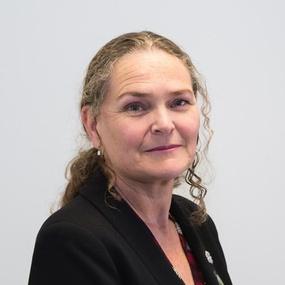
R A C H E L E S S O N
N A T I O N A L L I B R A R I A N
I e n c o u r a g e a n y o n e a t a n y p o i n t o f t h e i r c a r e e r t o w o r k t o w a r d s L I A N Z A P r o f e s s i o
c o n n e c t w i t h o t h e r p r o f e s s i o n a l s p a s s i o n a t e a b o u t t h e p l a c e o f l i b r a r i e s a n d i n f o r m a t i o n s e r v i c e s i
A o t
t h
, g r o w a n d p a r t i c i p a t e i n c o m m u n i t i e s , i n e d u c a t i o n , a n d i n e m p l o y m e n t
W H Y S H O U L D I R E G I S T E R ?
H E A H A A H A U I R Ē H I T A A I ?
G a i n r e c o g n i t i o n o f y o u r c o m m i t m e n t t o p r o f e s s i o n a l
s t a n d a r d s a n d e n h a n c e y o u r p r o f e s s i o n a l c o m p e t e n c e
t h r o u g h o u t y o u r c a r e e r
U s e t h e r e g i s t r a t i o n p r o c e s s a n d B o d i e s o f K n o w l e d g e
t o r e f l e c t o n y o u r o n g o i n g l e a r n i n g i n y o u r p r o f e s s i o n a l
p r a c t i c e
D e m o n s t r a t e y o u r e n g a g e m e n t w i t h t h e l a t e s t
i n n o v a t i o n a n d d e v e l o p m e n t s i n t h e p r o f e s s i o n
D i s p l a y y o u r c o m m i t m e n t t o p r o f e s s i o n a l l e a r n i n g t o
y o u r p e e r s , c u r r e n t a n d p r o s p e c t i v e e m p l o y e r s
G a i n g r e a t e r i n f l u e n c e w i t h i n y o u r o r g a n i s a t i o n a n d t h e
w i d e r s e c t o r .
O n c e y o u a r e r e g i s t e r e d y o u w i l l b e a b l e t o a d d
R L I A N Z A t o y o u r s i g n a t u r e
H O W D O I R E G I S T E R ?
M E P Ē H E A T A K U R Ē H I T A ?
J o i n L I A N Z A o r a n a f f i l i a t e d o r g a n i s a t i o n .
C o m p l e t e a n a p p l i c a t i o n f o r m .
C o n t a c t L I A N Z A f o r s u p p o r t
M I R L A E D M U N D S O N
G E N E R A L M A N A G E R , C O N N E C T E D C O M M U N I T I E S
A U C K L A N D C O U N C I L
A t A u c k l a n d L i b r a r i e s w e t a k e p r o f e s s i o n a l r e g i s t r a t i o n v e r y s e r i o u s l y f o r o u r s e n i o r a n d s p e c i a l i s t p r o f e s s i o n a l r o l e s I t n o t o n l y p r o v i d e s c a r e e r p r o g r e s s i o n d u e t o t h e h i g h e r p a y g r a d e s t h a t w e c a n a p p l y t o t h e s e n i o r r o l e s , i t a l s o g i v e s u s
c o n f i d e n c e t h a t t h e p e o p l e i n t h o s e s e n i o r r o l e s a r e u p - t o - d a t e r e f l e c t i v e p r o f e s s i o n a l s w h o h a v e t a k e n c a r e o f t h e i r o w n p r o f e s s i o n a l d e v e l o p m e n t
P R O F E S S I O N A L
R E G I S T R A T I O N
W H E N S H O U L D I
R E G I S T E R ?
Ā H E A A H A U E R Ē H I T A A I ?
Y o u c a n b e a t a n y a g e o r
s t a g e o f y o u r c a r e e r
R e c e n t g r a d u a t e s w i t h
V i c t o r i a U n i v e r s i t y o f
W e l l i n g t o n M a s t e r o r
P o s t g r a d u a t e D i p l o m a o f
I n f o r m a t i o n S t u d i e s a n d
O p e n P o l y t e c h n i c B a c h e l o r
o f L i b r a r y a n d I n f o r m a t i o n
S t u d i e s q u a l i f i c a t i o n s
a u t o m a t i c a l l y q u a l i f y t o
a p p l y f o r R L I A N Z A
L I A N Z A P r o f e s s i o n a l
R e g i s t r a t i o n a p p l i c a t i o n s
a n d r e v a l i d a t i o n s a r e
a c c e p t e d t h r o u g h o u t t h e
y e a r .
W H O C A N R E G I S T E R ?
K O W A I K A T A E A T E R Ē H I T A ?
A n y o n e w i t h a n a p p r o v e d
N e w Z e a l a n d l i b r a r y a n d
i n f o r m a t i o n q u a l i f i c a t i o n .
A n y o n e w i t h a l i b r a r y a n d
i n f o r m a t i o n q u a l i f i c a t i o n
r e c o g n i s e d b y
i n t e r n a t i o n a l l i b r a r y
a s s o c i a t i o n s
P e o p l e w i t h a b a c h e l o r ’ s
d e g r e e i n a n y f i e l d A N D
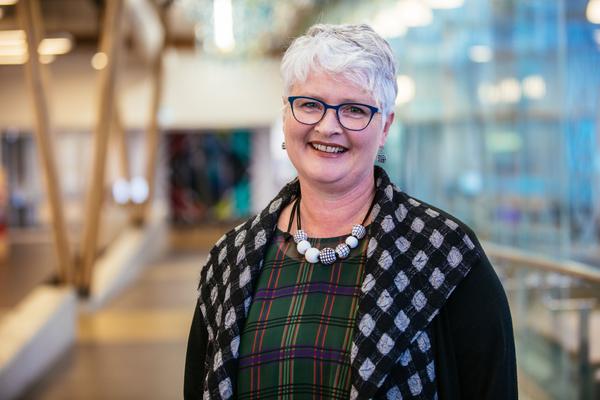
t h a t c a n d e m o n s t r a t e
t h r e e o r m o r e y e a r s o f
e x p e r i e n c e i n t h e
p r o f e s s i o n b y m a p p i n g t h i s
a g a i n s t a l l B o d i e s o f
K n o w l e d g e .
HISTORY CORNER

After attending the recent LIANZA webinar on the Freedom-to-read Toolkit I thought about how Aotearoa’s libraries haven’t always been champions for freedom to read, specifically about the controversy around the popular 1929 novel All Quiet on the Western Front.
Erich Maria Remarque’s novel was a global publishing sensation –the best-selling novel in the United States that year. Remarque was a German veteran of the First World War, and the book’s realistic depictions of trench warfare and other horrors of war caused an uproar when it was published.
When the book was considered for accession to New Zealand public libraries, All Quiet on the Western Front stirred up new controversy of quite another kind. The circumstances
around this are curious from a contemporary librarian’s perspective in that some library systems around the country would restrict access to it, but not all.
“The library authorities in Auckland, Wellington and Dunedin have decided that their institutions shall not be used to circulate the volume, and they are well within their province in so deciding.”
The foresighted and liberal librarian of the Canterbury Public Library decided not to censor the book and said it should be approved by everyone who gives the subject serious thought.
It was allowed into the country and able to be purchased. The booksellers of the day took advantage of a great marketing opportunity.
From this situation in 1929, we go to 1945 when another bestseller – Forever Amber, was banned in Australia and then prohibited entry into New Zealand by the Customs Department. However, not before some copies made it into circulating libraries. The Auckland Star reported that Wellington Central Library had four copies of the American edition and were in heavy demand by the reading public with a waiting list.
LIANZA’s precursor, the NZLA, campaigned against banning this book. This was a sea change in how libraries approached this issue, in only a decade and a half since the All Quiet on the Western Front situation.
This change from judging books on literary merit to fighting to uphold the freedom to read changes with Forever Amber. Ina report by the (NZLA’s)

Fiction Committee all members agreed that “Forever Amber is a trivial and naive work; two characterise it as monotonous.”
The report, written by Sadie M. Foote, convenor of the committee, states that there was a cause for concern regarding the grounds on which the book was banned – ‘prominence to sex’ could apply to any number of ‘serious’ works and that banning a work for this was setting a dangerous precedent. They say “that censorship in this country is casual, arbitrary, and ill-informed.” The report then recommends the Association challenge the existing conditions.
How did we get from different restrictions on reading from town to town to having a unified challenge to censorship?
This organised and strong response can be attributed to the strengthening of the Library

Association in the time between these two controversial novels being published.
In his presidential address at the NZLA conference in 1946, John Barr was effusive in his praise of the strength of the Association. He recounted Ralph Munn’s sincere praise that the development of New Zealand’s libraries over the previous five years was one of the minor marvels of the war. A lot had happened in the profession during the war years. In 1945 alone, the NZLA council had successfully recommended to the Government that a library school be established and a National Library Centre be created.
He goes on, “I can honestly say that I have never belonged to an Association in which so many people have worked so well and so selflessly for the
advancement of its objectives. It is undoubtedly due to this that our Association stands where it does today.”
SOURCES
• Barr, John. Presidential Address in Proceedings and papers of fifteenth conference of representatives… 5-7 February 1946 / The Libraries Association of New Zealand, pp. 19-24.
• Foote, Sadie M. “Forever Amber” in New Zealand Libraries : Bulletin of the N.Z. Library Association Inc. vol. 9, no. 1, Jan.-Feb. 1946, pp. 9-10.
• Paperspast; Paxton, Chris. In the West, much news
Andrew Henry RLIANZA (biblio-centric Instagram @aklbn11) is Principal Aotearoa/NZ Collections librarian based at the Central City Library in Tāmaki Makaurau.
FREEDOM OF INFO
IS IT APPROPRIATE FOR THE COLLECTION? HAVING ROBUST SCHOOL LIBRARY POLICIES IS ESSENTIAL


In the US, the American Library Association (ALA) endorses April as School Library Month. This month is a time to celebrate the essential role school libraries play in transforming learning. The Library Research Service indicates studies that show how school librarians are linked to improved test scores for students through librarians teaching information literacy, being professionally trained, collaborating with teachers, extending their opening hours, providing training to teachers, having new and larger collections, higher budgets, higher student visits, and flexible scheduling.
The school library collection is a complex balancing act. It provides a diverse and inclusive collection for their students, acting in loco parentis to keep students safe from harm, adhering to libraries core ethic of freedom of access to information and intellectual freedom, and meeting the needs of the school, its curriculum, and the school’s ethos. All these perspectives could present different ideas and competing priorities about what belongs in the library’s collection.
Amidst this is the eternal question of what ‘appropriate’ means, who gets to determine what is appropriate and for whom. The School Library Journal Controversial Books Survey (2016) found that ‘not age appropriate’ was the top reason why school librarians self-censored books, followed
by concerns about the reaction from parents or the school. Their sample showed that 9 in 10 primary school librarians, and 73% of high school librarians passed on purchasing a book because of potentially controversial topics.
Self-censorship has an almost insidious, shameful tone in our industry. In reality librarians carry out self-censorship for a variety of reasons other than just their own views on the information. Reasons include fear of controversy, concern about the appropriateness of the content, budget and space constraints, or external pressure from teachers, parents, community groups, or school leadership.
The School Journal study also found that school librarians reported an increase in teen and young adult content which was “graphic” or “explicit”, particularly in relation to sexual or violent content. This plays out in the contemporary context of young people’s exposure to such content online. Young people have access to this type of unregulated online content, whether school librarians like it or not. Meanwhile, literature serves as a tool to reflect a young person’s cultural and lived experience, enabling them to learn about themselves through reflection and identification. Libraries can deliver this content in a safe and trusted setting, with professionals on hand to answer questions or facilitate conversations about
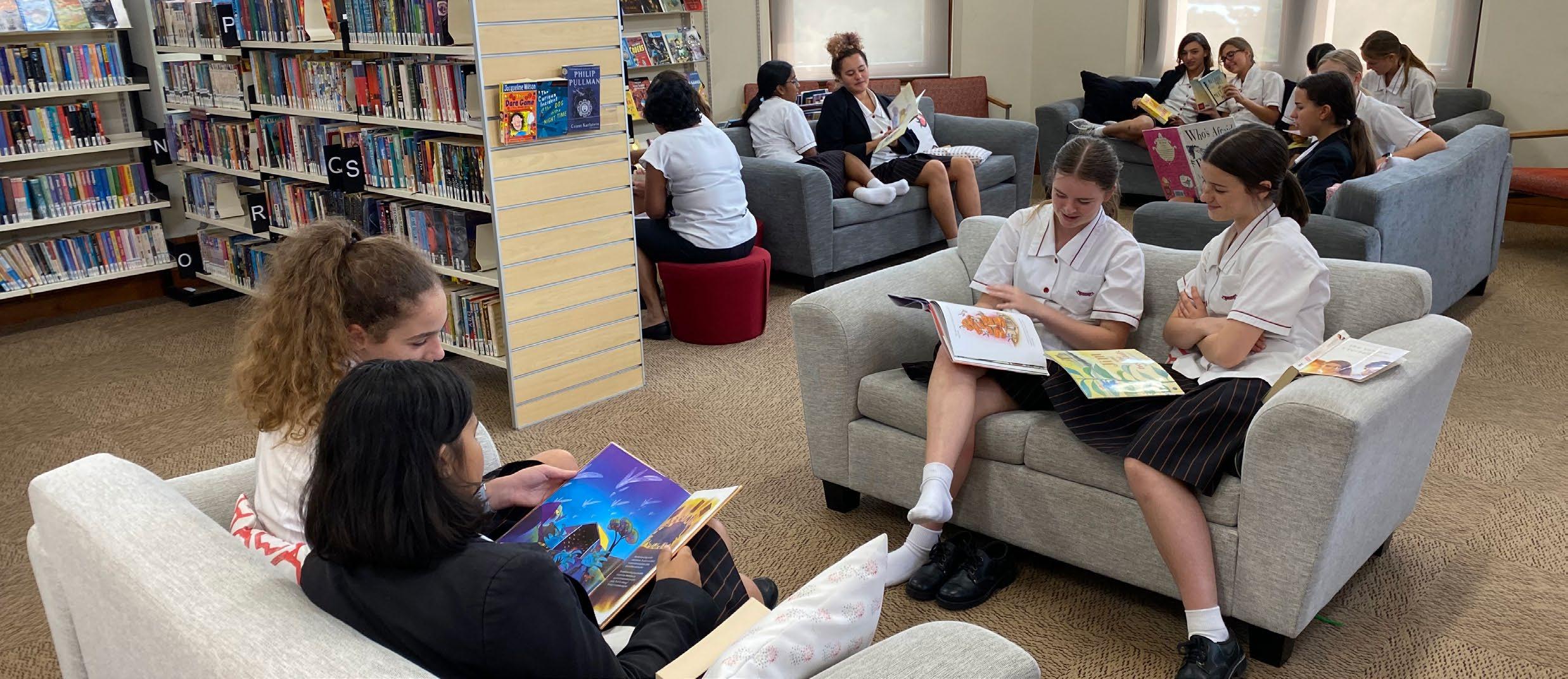
the material. Librarian Emily Calkins argues that librarians should protect teens’ individual right to intellectual freedom due to the significant developmental changes that teenagers undergo between ages 12 and 18 years. The process of finding autonomy, independence, forming their own ideas and individuating from their guardians are hallmarks of this phase, she says. Calkins advocates to facilitate and allow young people’s information discovery journey on their own terms, with less of a focus on guardian involvement than we would for children.
Robust and up-to-date collection policies are librarians’ solutions to making tricky decisions about what is in their collection. If your school library doesn’t have collection policies, it’s time to create them! The National Library’s Services to School website has extensive resources on collection management to assist you. They recommend a wide range of high-quality resources that enable students to develop information skills, foster critical thinking, and extend their interest and knowledge of the world and their place in it. In general, your collection management policy should cover the strategy and vision for developing the library, aligned with that of the school, the process and guidelines for selecting resources, how to manage donations, procedures for weeding/ de-selection, how to handle complaints about resources, and any various statements you’re committed to, such as copyright, privacy, and intellectual freedom. Your policy will help you make decisions about the collection, and advocate when items are questioned. Having a robust complaints procedure in place is essential to being prepared
for managing complaints and being able to justify your decisions.
School libraries do make decisions about what does and does not go into the collection, so what’s the difference between self-censorship and selection? Perhaps the answer is that selection occurs in consultation within a professionally informed collection management policy, and selfcensorship occurs in absentia of a policy, or without consulting the policy to guide the decision.
Censorship and access are on a sliding scale and school librarians can make choices about access to strike a balance if their various priorities are conflicting. For example, you could keep something in a Year 13-only section, put a content warning sticker on a book, or keep the book behind the desk, meaning the librarian can have a conversation about it.
Lastly, we invite school libraries to involve the students in the process of determining your collection. Consider running an anonymous survey, questionnaire, or feedback box to discover what students want in their library collections. Giving the students input into their library increases their engagement and makes them feel considered and respected.
This column was written by Marlies Zyp-van der Laan RLIANZA, Team Leader Online Researcher Services at Auckland Libraries. Marlies is a member of the LIANZA Standing Committee on Freedom of Information.
CLIMATE ACTION

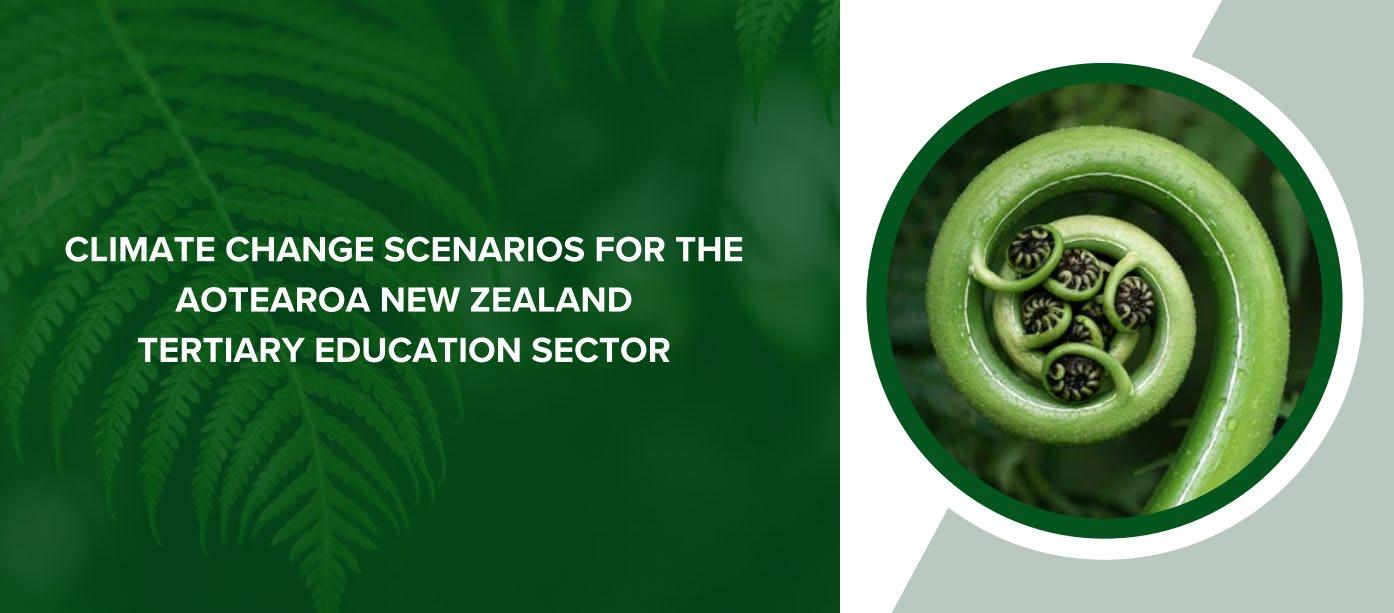
The LIANZA Standing Committee on Climate Action is very pleased to have released the LIANZA Statement on Climate Action in March 2024. Developing the statement has been a key piece of work for the committee since its establishment in July 2023. We’re proud to have this statement as a formal acknowledgment that LIANZA recognises we are living in a climate crisis and that libraries have an important part to play in society’s response to this crisis.
With the release of this statement, LIANZA is now aligned with fellow library associations like ALIA and local government colleagues and organisations who have taken similar symbolic and necessary steps to unify the library and information sector around this key issue and demonstrate a commitment to climate action. Read the statement here.
HOW WILL CLIMATE CHANGE IMPACT AOTEAROA’S TERTIARY EDUCATION SECTOR?
The Tertiary Education Sector Climate Futures Group (TESCFG) recently released a report titled Climate Change Scenarios for the Aotearoa New Zealand Tertiary Education Sector. The report by TESCFG, an advisory group with members from tertiary education providers across the country, seeks to outline the possible outcomes to the question: How will climate change impact Aotearoa New Zealand’s tertiary education sector between now and 2100?
The report makes for a concerning read for the whole tertiary education sector, tertiary librarians and information professionals included. Climate change is likely to worsen their financial conditions, potentially reducing student numbers, with smaller campuses and strong competition from overseas
education providers. However, the report is not all doom and gloom. The authors emphasise the importance of the “collective effort” needed to keep global warming to a minimum and ease the worst effects of climate change, arguing that “there is a critical role for the tertiary education sector to play in reducing emissions and pushing for wider change.” (2024; p 40).
Overall, the report is a fascinating and very useful read for the New Zealand tertiary sector, with the range of scenarios outlined in a way that invites individual tertiary institutions to identify the risks and opportunities relevant to their organisation for each scenario, providing a practical framework for climate adaptation planning. If you are a tertiary librarian, check this report out. We guarantee you’ll have a giggle at the quirky scenario titles which draw on local idioms “Sweet As”, “She’ll Be Right”, “Yeah, Nah” and “Oh Bugger!”.

ELECTRIC BOOKBUS SPOTTING AROUND AOTEAROA
Did you know that Upper Hutt Libraries were the first library system in Aotearoa to launch an electric vehicle mobile library service? Back in 2021, Mangaroa, a fully electric van was launched providing outreach access to communities throughout Upper Hutt. LIANZA Standing Committee on Climate Action member Marion Read was Upper Hutt Libraries Manager at the time of Mangaroa’s launch. Marion noted that the custom built van, named after the Mangaroa River which travels the full length of Upper Hutt providing lifesupporting nutrients to Te Awa Kairangi (the Hutt River), was “worth the wait”.
In January 2023, Dunedin Public Libraries joined the electric bookbus club with the introduction of Te Pahi Pukapuka. Carrying over 2000 books, Te Pahi Pukapuka provides mobile library services
across Ōtepoti Dunedin and fits with Dunedin City Council’s Zero Carbon Plan 2030. Like Mangaroa, Te Pahi Pukapuka has a close connection with Ōtepoti’s local landscape, with artwork by Dunedin-based artist Aroha Novak invoking the story of Matamata, a taniwha from Kāti Māmoe tradition believed to have carved out the Otago Harbour and formed the shape of the Taiari River (the correct spelling of Taieri River).
We look forward to hearing about more library systems switching to electric, low carbon alternatives for service provision! If your organisation is doing anything exciting in the climate action space, please get in touch with us to share via climate@ lianza.org.nz – we would love to hear from you!
CELEBRATE EARTH DAY: 22 APRIL
Earth Day is just around the corner and is a globallycelebrated annual event for
communities to show their support for environmental protection. Looking for quick and simple actions to encourage your organisation or community to get involved with Earth Day? Here are a few ideas:
• Put together a library display with books and other resources centred around protection of Papatūānuku and Te Taiao.
• Create and share an online book list like this one on Climate Change from Auckland Libraries.
• Host an Earth Day morning tea and use the time to share local environmental volunteering opportunities, encouraging your colleagues to sign up for a shift.
This column has been written by Alexis McCullough, chair of the LIANZA Climate Action Standing Committee.

